Accounting and Finance Project 2017-18
VerifiedAdded on 2023/06/15
|26
|4861
|460
AI Summary
This project analyzes the performance of Tesco, Sainsbury's and Morrisons in the UK supermarket retail industry using PESTE analysis, Porter's Five Forces and SWOT analysis. It also includes financial and non-financial ratio analysis.
Contribute Materials
Your contribution can guide someone’s learning journey. Share your
documents today.

Acc 4003 Interim Project
Secure Best Marks with AI Grader
Need help grading? Try our AI Grader for instant feedback on your assignments.
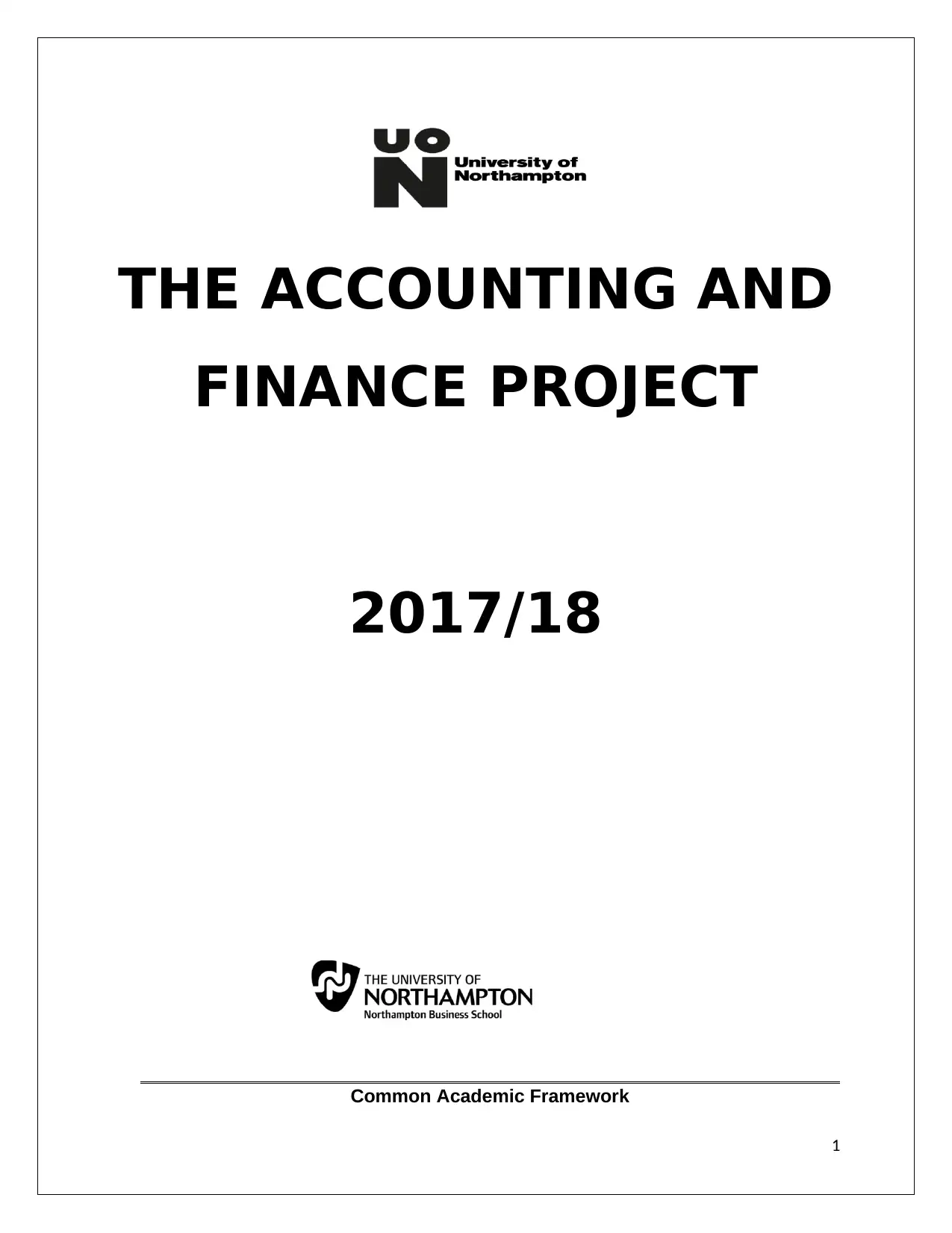
THE ACCOUNTING AND
FINANCE PROJECT
2017/18
Common Academic Framework
1
FINANCE PROJECT
2017/18
Common Academic Framework
1

Accounting & Finance Front Project Sheet
NB. This sheet must be attached to any submission of Accounting & Finance field
module coursework. No assignment will be accepted without it.
Student Name:
Student ID:
Title of Module: Accounting and Finance Project 2017-8
Module Code: ACC4003 STD/IL
Title of Coursework:
Module Leader: Tambu Mangezi
Dissertation Supervisor:
Hand In Date:
Checklist before submission
1. Have you read, understood and acted in accordance with the referencing guidelines set
out in the appropriate Accounting & Finance Module Guide.
2. Where you have quoted directly from or where you have paraphrased the work of others,
have you acknowledged and appropriately referenced the source of your quotation in the
body of the text?
3. Have you placed all direct quotations in inverted commas?
4. Have you listed and correctly cited all your sources in your reference list and
bibliography?
Declaration by the candidate named above
1. I confirm that this is my own work (or, in the case of a group assignment, the work of my
group) and that, although I may have consulted others in the course of assembling
material for the work, the finished article has been completed without help or
2
NB. This sheet must be attached to any submission of Accounting & Finance field
module coursework. No assignment will be accepted without it.
Student Name:
Student ID:
Title of Module: Accounting and Finance Project 2017-8
Module Code: ACC4003 STD/IL
Title of Coursework:
Module Leader: Tambu Mangezi
Dissertation Supervisor:
Hand In Date:
Checklist before submission
1. Have you read, understood and acted in accordance with the referencing guidelines set
out in the appropriate Accounting & Finance Module Guide.
2. Where you have quoted directly from or where you have paraphrased the work of others,
have you acknowledged and appropriately referenced the source of your quotation in the
body of the text?
3. Have you placed all direct quotations in inverted commas?
4. Have you listed and correctly cited all your sources in your reference list and
bibliography?
Declaration by the candidate named above
1. I confirm that this is my own work (or, in the case of a group assignment, the work of my
group) and that, although I may have consulted others in the course of assembling
material for the work, the finished article has been completed without help or
2
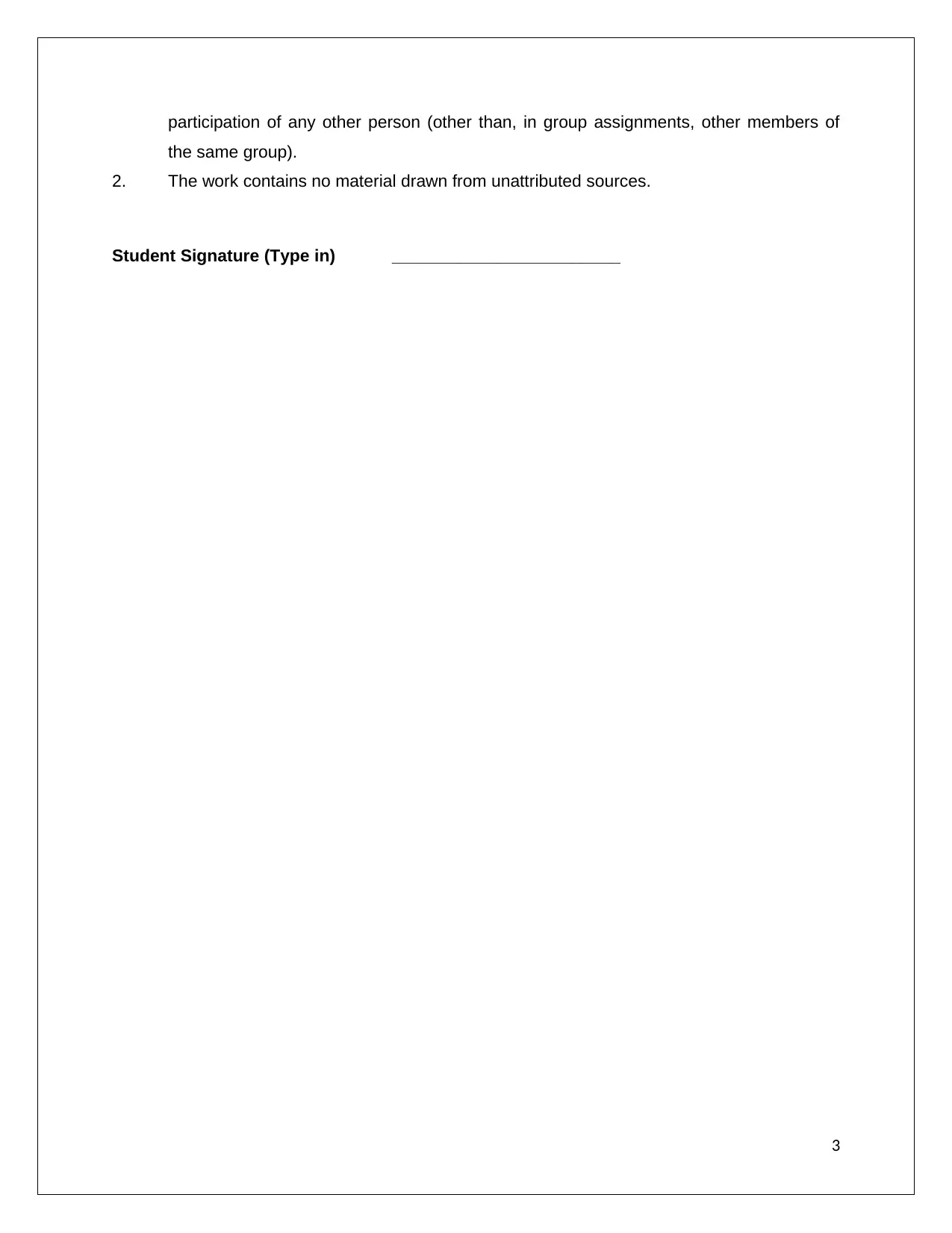
participation of any other person (other than, in group assignments, other members of
the same group).
2. The work contains no material drawn from unattributed sources.
Student Signature (Type in) ________________________
3
the same group).
2. The work contains no material drawn from unattributed sources.
Student Signature (Type in) ________________________
3
Paraphrase This Document
Need a fresh take? Get an instant paraphrase of this document with our AI Paraphraser
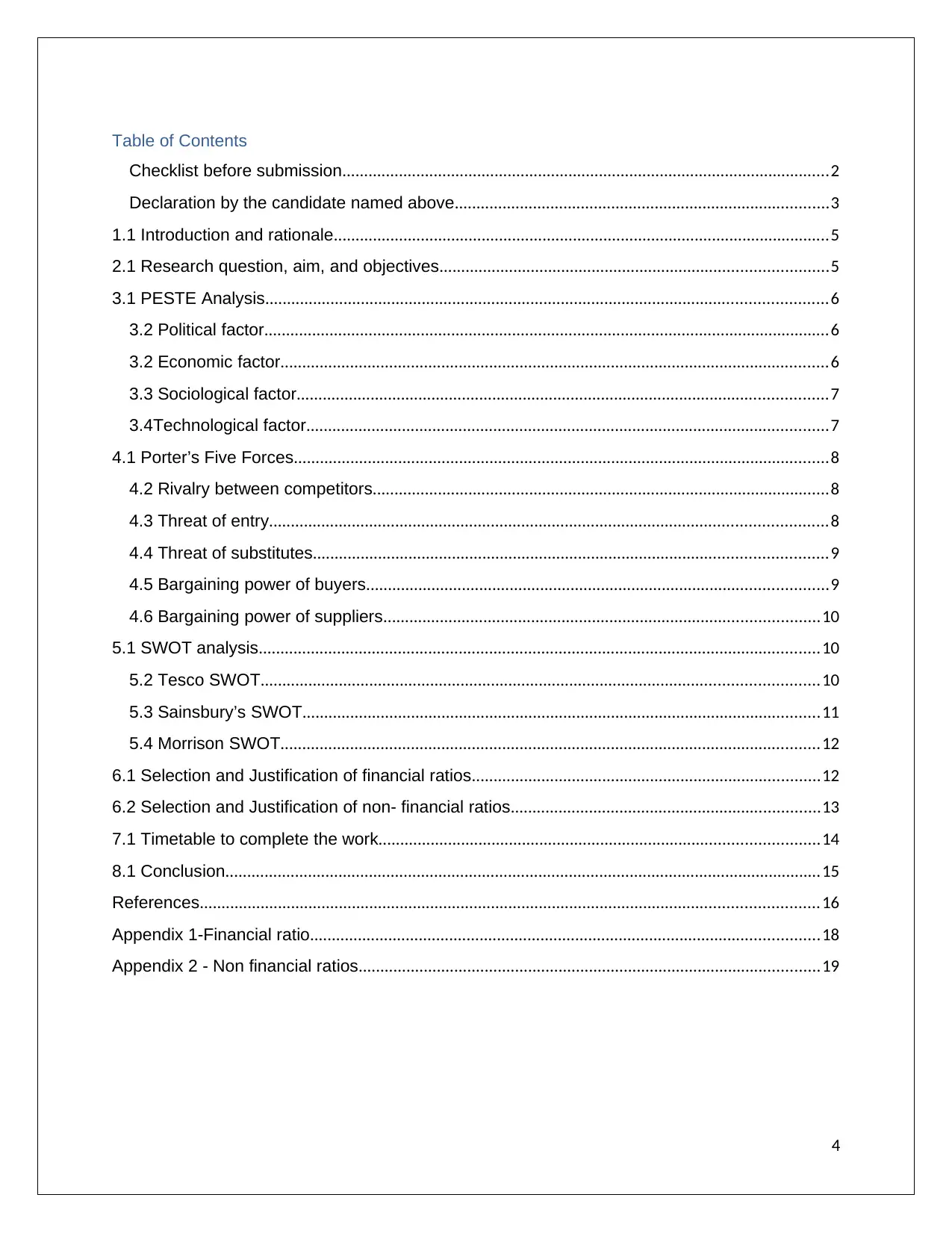
Table of Contents
Checklist before submission................................................................................................................2
Declaration by the candidate named above......................................................................................3
1.1 Introduction and rationale..................................................................................................................5
2.1 Research question, aim, and objectives.........................................................................................5
3.1 PESTE Analysis.................................................................................................................................6
3.2 Political factor..................................................................................................................................6
3.2 Economic factor..............................................................................................................................6
3.3 Sociological factor..........................................................................................................................7
3.4Technological factor........................................................................................................................7
4.1 Porter’s Five Forces...........................................................................................................................8
4.2 Rivalry between competitors.........................................................................................................8
4.3 Threat of entry................................................................................................................................8
4.4 Threat of substitutes......................................................................................................................9
4.5 Bargaining power of buyers..........................................................................................................9
4.6 Bargaining power of suppliers....................................................................................................10
5.1 SWOT analysis.................................................................................................................................10
5.2 Tesco SWOT................................................................................................................................10
5.3 Sainsbury’s SWOT.......................................................................................................................11
5.4 Morrison SWOT............................................................................................................................12
6.1 Selection and Justification of financial ratios................................................................................12
6.2 Selection and Justification of non- financial ratios.......................................................................13
7.1 Timetable to complete the work.....................................................................................................14
8.1 Conclusion.........................................................................................................................................15
References..............................................................................................................................................16
Appendix 1-Financial ratio.....................................................................................................................18
Appendix 2 - Non financial ratios..........................................................................................................19
4
Checklist before submission................................................................................................................2
Declaration by the candidate named above......................................................................................3
1.1 Introduction and rationale..................................................................................................................5
2.1 Research question, aim, and objectives.........................................................................................5
3.1 PESTE Analysis.................................................................................................................................6
3.2 Political factor..................................................................................................................................6
3.2 Economic factor..............................................................................................................................6
3.3 Sociological factor..........................................................................................................................7
3.4Technological factor........................................................................................................................7
4.1 Porter’s Five Forces...........................................................................................................................8
4.2 Rivalry between competitors.........................................................................................................8
4.3 Threat of entry................................................................................................................................8
4.4 Threat of substitutes......................................................................................................................9
4.5 Bargaining power of buyers..........................................................................................................9
4.6 Bargaining power of suppliers....................................................................................................10
5.1 SWOT analysis.................................................................................................................................10
5.2 Tesco SWOT................................................................................................................................10
5.3 Sainsbury’s SWOT.......................................................................................................................11
5.4 Morrison SWOT............................................................................................................................12
6.1 Selection and Justification of financial ratios................................................................................12
6.2 Selection and Justification of non- financial ratios.......................................................................13
7.1 Timetable to complete the work.....................................................................................................14
8.1 Conclusion.........................................................................................................................................15
References..............................................................................................................................................16
Appendix 1-Financial ratio.....................................................................................................................18
Appendix 2 - Non financial ratios..........................................................................................................19
4

1.1 Introduction and rationale
Three companies named as Tesco, Sainsbury’s and Morrisons dominate the supermarket retail
chain in UK. After the economic recession, there was increase in food prices as well as
tightened belts where the supermarket retail industry was shaken by the British consumers
search for value. According to sources, these three supermarket retail giants have lost market
share in the first three months for the year 2016 August.
The retail industry in UK recently is having global presence as they now have proper knowledge
about the demand that is needed in this competitive market and how to bring regulatory
changes at the time of explaining the level of transparency. The retail industry in UK is now
been incorporating new and improved services in the market and able to provide services that
meet the need of the customers. The feature of retail sector in UK has the ability to render
different types of retail products and services to their consumers and developing supermarket
chains.
For this study, supermarket retail chain in UK has been selected because these three
companies are giving stiff competition to one other and making strategy to retain their position in
this competitive world.
Justification for selecting retail sector for this study
In this study, retail sector had been selected because it is noted that the consumers are facing
difficulty as there is rapid transition and frequent changes in tastes and preferences with
passage of time. It is even noted that different products and services had been evolved and this
is the reason why tastes and preferences of consumers are changing at a rapid pace. Because
of these factors, retail sector is selected for understanding the kind of products needed by the
customers and what is this business look like with the help of business model that are
5
Three companies named as Tesco, Sainsbury’s and Morrisons dominate the supermarket retail
chain in UK. After the economic recession, there was increase in food prices as well as
tightened belts where the supermarket retail industry was shaken by the British consumers
search for value. According to sources, these three supermarket retail giants have lost market
share in the first three months for the year 2016 August.
The retail industry in UK recently is having global presence as they now have proper knowledge
about the demand that is needed in this competitive market and how to bring regulatory
changes at the time of explaining the level of transparency. The retail industry in UK is now
been incorporating new and improved services in the market and able to provide services that
meet the need of the customers. The feature of retail sector in UK has the ability to render
different types of retail products and services to their consumers and developing supermarket
chains.
For this study, supermarket retail chain in UK has been selected because these three
companies are giving stiff competition to one other and making strategy to retain their position in
this competitive world.
Justification for selecting retail sector for this study
In this study, retail sector had been selected because it is noted that the consumers are facing
difficulty as there is rapid transition and frequent changes in tastes and preferences with
passage of time. It is even noted that different products and services had been evolved and this
is the reason why tastes and preferences of consumers are changing at a rapid pace. Because
of these factors, retail sector is selected for understanding the kind of products needed by the
customers and what is this business look like with the help of business model that are
5
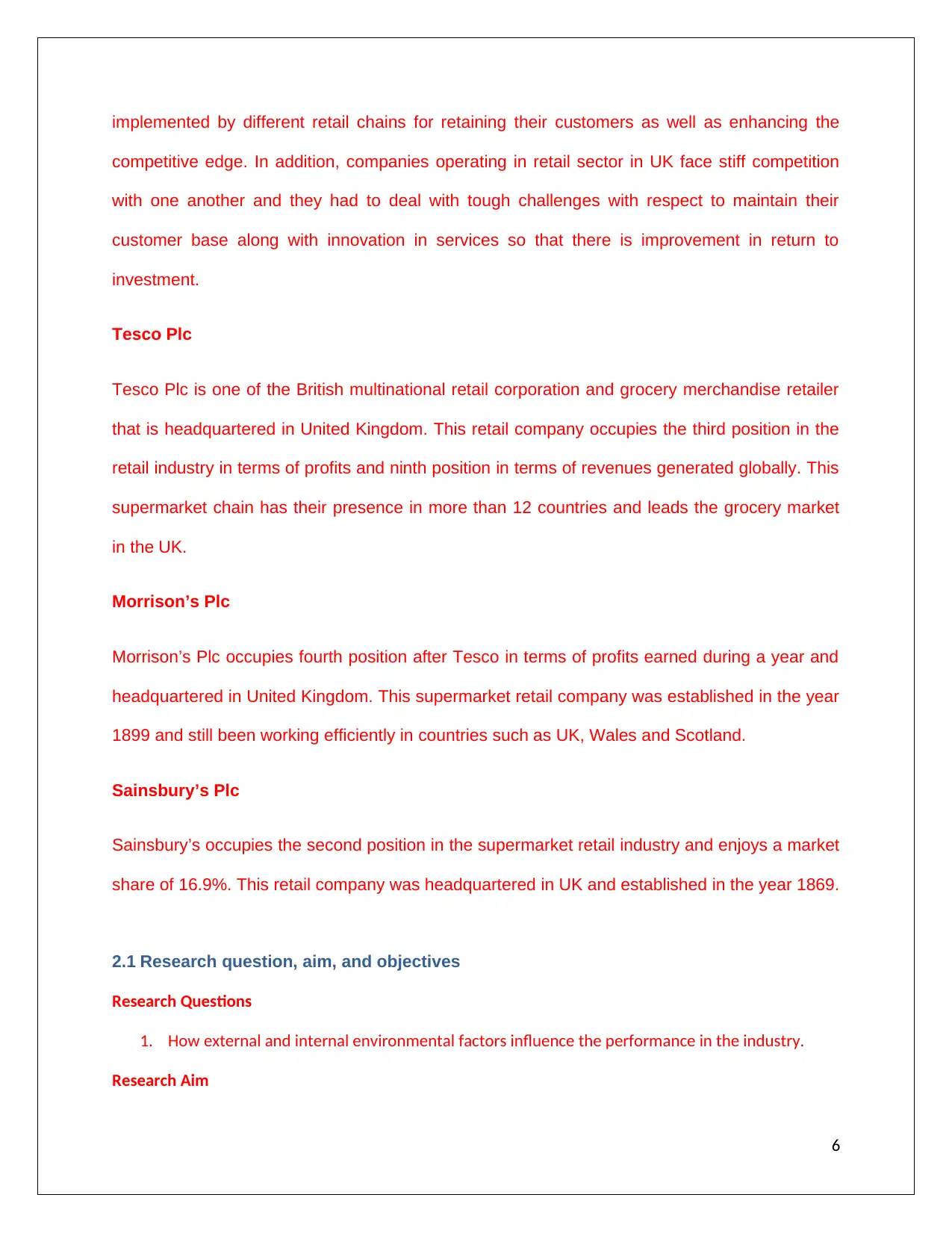
implemented by different retail chains for retaining their customers as well as enhancing the
competitive edge. In addition, companies operating in retail sector in UK face stiff competition
with one another and they had to deal with tough challenges with respect to maintain their
customer base along with innovation in services so that there is improvement in return to
investment.
Tesco Plc
Tesco Plc is one of the British multinational retail corporation and grocery merchandise retailer
that is headquartered in United Kingdom. This retail company occupies the third position in the
retail industry in terms of profits and ninth position in terms of revenues generated globally. This
supermarket chain has their presence in more than 12 countries and leads the grocery market
in the UK.
Morrison’s Plc
Morrison’s Plc occupies fourth position after Tesco in terms of profits earned during a year and
headquartered in United Kingdom. This supermarket retail company was established in the year
1899 and still been working efficiently in countries such as UK, Wales and Scotland.
Sainsbury’s Plc
Sainsbury’s occupies the second position in the supermarket retail industry and enjoys a market
share of 16.9%. This retail company was headquartered in UK and established in the year 1869.
2.1 Research question, aim, and objectives
Research Questions
1. How external and internal environmental factors influence the performance in the industry.
Research Aim
6
competitive edge. In addition, companies operating in retail sector in UK face stiff competition
with one another and they had to deal with tough challenges with respect to maintain their
customer base along with innovation in services so that there is improvement in return to
investment.
Tesco Plc
Tesco Plc is one of the British multinational retail corporation and grocery merchandise retailer
that is headquartered in United Kingdom. This retail company occupies the third position in the
retail industry in terms of profits and ninth position in terms of revenues generated globally. This
supermarket chain has their presence in more than 12 countries and leads the grocery market
in the UK.
Morrison’s Plc
Morrison’s Plc occupies fourth position after Tesco in terms of profits earned during a year and
headquartered in United Kingdom. This supermarket retail company was established in the year
1899 and still been working efficiently in countries such as UK, Wales and Scotland.
Sainsbury’s Plc
Sainsbury’s occupies the second position in the supermarket retail industry and enjoys a market
share of 16.9%. This retail company was headquartered in UK and established in the year 1869.
2.1 Research question, aim, and objectives
Research Questions
1. How external and internal environmental factors influence the performance in the industry.
Research Aim
6
Secure Best Marks with AI Grader
Need help grading? Try our AI Grader for instant feedback on your assignments.
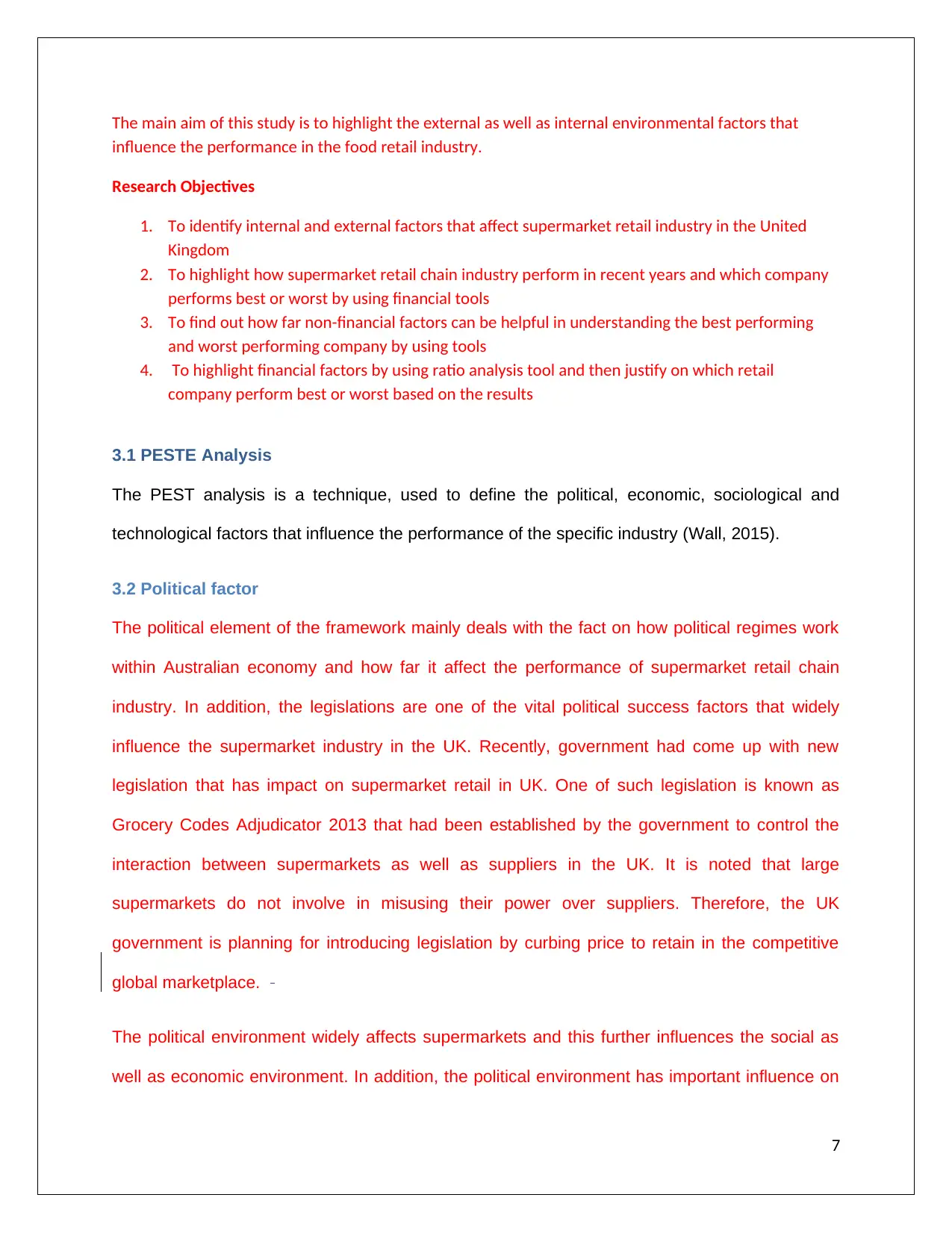
The main aim of this study is to highlight the external as well as internal environmental factors that
influence the performance in the food retail industry.
Research Objectives
1. To identify internal and external factors that affect supermarket retail industry in the United
Kingdom
2. To highlight how supermarket retail chain industry perform in recent years and which company
performs best or worst by using financial tools
3. To find out how far non-financial factors can be helpful in understanding the best performing
and worst performing company by using tools
4. To highlight financial factors by using ratio analysis tool and then justify on which retail
company perform best or worst based on the results
3.1 PESTE Analysis
The PEST analysis is a technique, used to define the political, economic, sociological and
technological factors that influence the performance of the specific industry (Wall, 2015).
3.2 Political factor
The political element of the framework mainly deals with the fact on how political regimes work
within Australian economy and how far it affect the performance of supermarket retail chain
industry. In addition, the legislations are one of the vital political success factors that widely
influence the supermarket industry in the UK. Recently, government had come up with new
legislation that has impact on supermarket retail in UK. One of such legislation is known as
Grocery Codes Adjudicator 2013 that had been established by the government to control the
interaction between supermarkets as well as suppliers in the UK. It is noted that large
supermarkets do not involve in misusing their power over suppliers. Therefore, the UK
government is planning for introducing legislation by curbing price to retain in the competitive
global marketplace.
The political environment widely affects supermarkets and this further influences the social as
well as economic environment. In addition, the political environment has important influence on
7
influence the performance in the food retail industry.
Research Objectives
1. To identify internal and external factors that affect supermarket retail industry in the United
Kingdom
2. To highlight how supermarket retail chain industry perform in recent years and which company
performs best or worst by using financial tools
3. To find out how far non-financial factors can be helpful in understanding the best performing
and worst performing company by using tools
4. To highlight financial factors by using ratio analysis tool and then justify on which retail
company perform best or worst based on the results
3.1 PESTE Analysis
The PEST analysis is a technique, used to define the political, economic, sociological and
technological factors that influence the performance of the specific industry (Wall, 2015).
3.2 Political factor
The political element of the framework mainly deals with the fact on how political regimes work
within Australian economy and how far it affect the performance of supermarket retail chain
industry. In addition, the legislations are one of the vital political success factors that widely
influence the supermarket industry in the UK. Recently, government had come up with new
legislation that has impact on supermarket retail in UK. One of such legislation is known as
Grocery Codes Adjudicator 2013 that had been established by the government to control the
interaction between supermarkets as well as suppliers in the UK. It is noted that large
supermarkets do not involve in misusing their power over suppliers. Therefore, the UK
government is planning for introducing legislation by curbing price to retain in the competitive
global marketplace.
The political environment widely affects supermarkets and this further influences the social as
well as economic environment. In addition, the political environment has important influence on
7
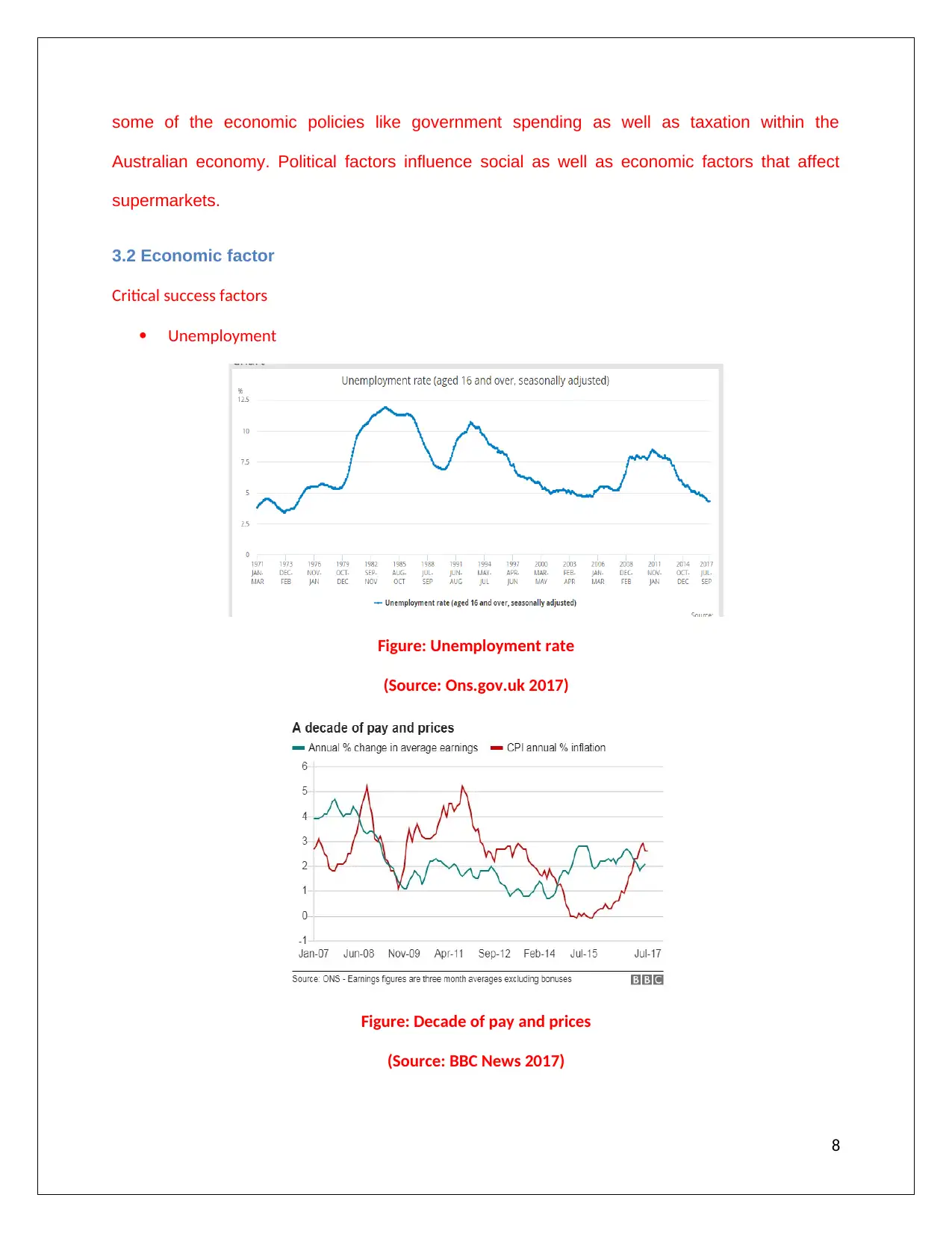
some of the economic policies like government spending as well as taxation within the
Australian economy. Political factors influence social as well as economic factors that affect
supermarkets.
3.2 Economic factor
Critical success factors
Unemployment
Figure: Unemployment rate
(Source: Ons.gov.uk 2017)
Figure: Decade of pay and prices
(Source: BBC News 2017)
8
Australian economy. Political factors influence social as well as economic factors that affect
supermarkets.
3.2 Economic factor
Critical success factors
Unemployment
Figure: Unemployment rate
(Source: Ons.gov.uk 2017)
Figure: Decade of pay and prices
(Source: BBC News 2017)
8

The above diagram shows earnings figures from 2007 to 2017. The employment picture remains strong
with a new record of high employment rate as well as another fall in the rate of unemployment. Real
earnings continue to decline. It is noted that pay rise improved by 2.1% as compared with consensus
prediction of 2%.
Inflation
Figure: Sales at food stores rose by 1.5% (2017)
(Source: Partington 2017)
Clothing and footwear retailers badly hit in the month of July amid volatile trends as stated by Office
for National Statistics. The consumers are taking approach that is more cautious at the time of
shopping when there was higher inflation rate above the level of earnings eats into their spending
power.
3.3 Sociological factor
Critical success factor
UK population
9
with a new record of high employment rate as well as another fall in the rate of unemployment. Real
earnings continue to decline. It is noted that pay rise improved by 2.1% as compared with consensus
prediction of 2%.
Inflation
Figure: Sales at food stores rose by 1.5% (2017)
(Source: Partington 2017)
Clothing and footwear retailers badly hit in the month of July amid volatile trends as stated by Office
for National Statistics. The consumers are taking approach that is more cautious at the time of
shopping when there was higher inflation rate above the level of earnings eats into their spending
power.
3.3 Sociological factor
Critical success factor
UK population
9
Paraphrase This Document
Need a fresh take? Get an instant paraphrase of this document with our AI Paraphraser
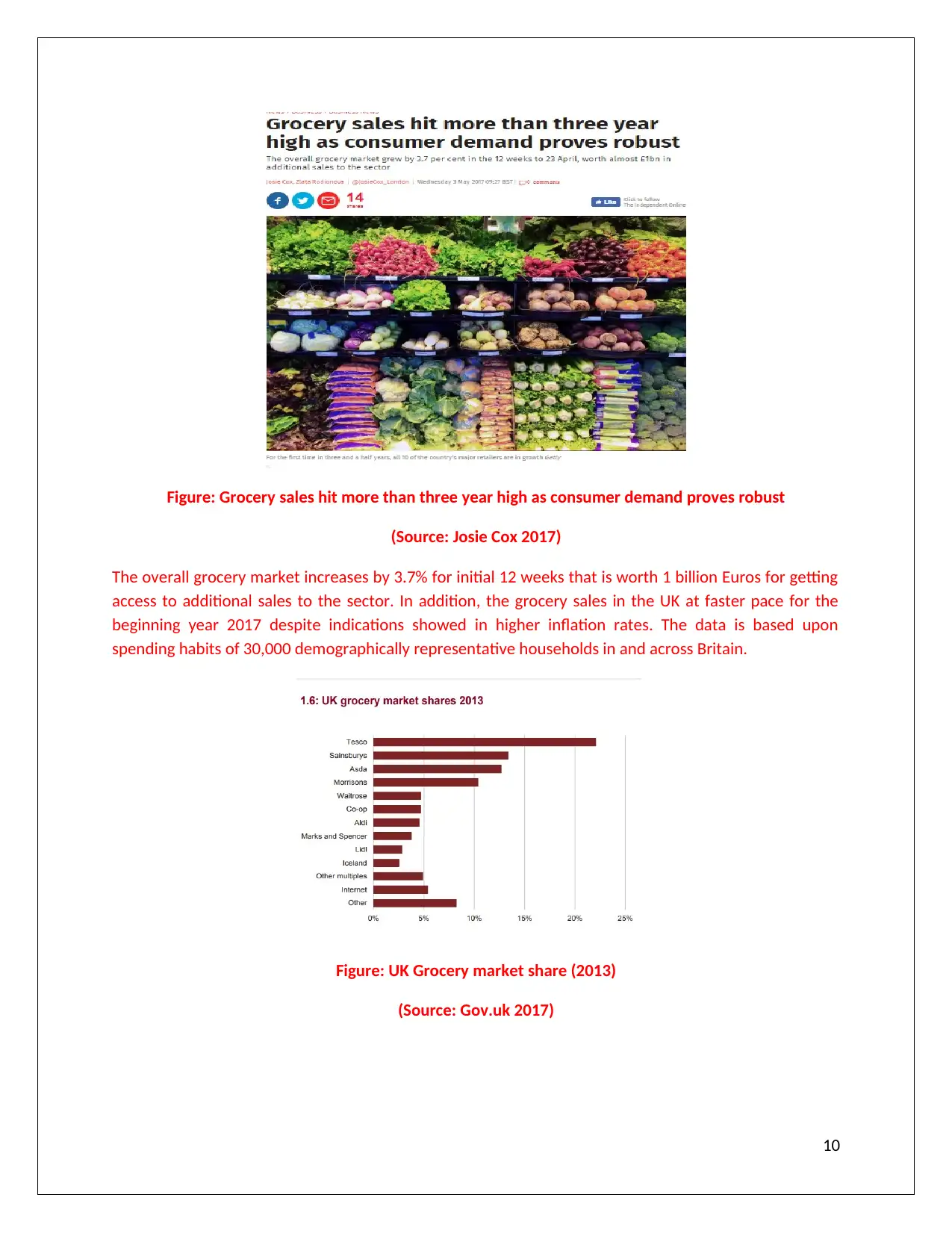
Figure: Grocery sales hit more than three year high as consumer demand proves robust
(Source: Josie Cox 2017)
The overall grocery market increases by 3.7% for initial 12 weeks that is worth 1 billion Euros for getting
access to additional sales to the sector. In addition, the grocery sales in the UK at faster pace for the
beginning year 2017 despite indications showed in higher inflation rates. The data is based upon
spending habits of 30,000 demographically representative households in and across Britain.
Figure: UK Grocery market share (2013)
(Source: Gov.uk 2017)
10
(Source: Josie Cox 2017)
The overall grocery market increases by 3.7% for initial 12 weeks that is worth 1 billion Euros for getting
access to additional sales to the sector. In addition, the grocery sales in the UK at faster pace for the
beginning year 2017 despite indications showed in higher inflation rates. The data is based upon
spending habits of 30,000 demographically representative households in and across Britain.
Figure: UK Grocery market share (2013)
(Source: Gov.uk 2017)
10

Figure: UK trend in food prices in real terms (1996 to 2015)
(Source: Gov.uk 2017)
3.4Technological factor
Critical success factor
Online shopping
Figure: Online sales grew by 19% in April and e-grocery sales by 17%
(Source: Rigby 2017)
It is noted that e-commerce sales increases by 19% and online grocery increases 17.6%. In addition,
ecommerce sales growth of 13.9%
4.1 Porter’ Five Forces
Porter’s five forces do the analyses of the industry’s competitor’s review.
11
(Source: Gov.uk 2017)
3.4Technological factor
Critical success factor
Online shopping
Figure: Online sales grew by 19% in April and e-grocery sales by 17%
(Source: Rigby 2017)
It is noted that e-commerce sales increases by 19% and online grocery increases 17.6%. In addition,
ecommerce sales growth of 13.9%
4.1 Porter’ Five Forces
Porter’s five forces do the analyses of the industry’s competitor’s review.
11
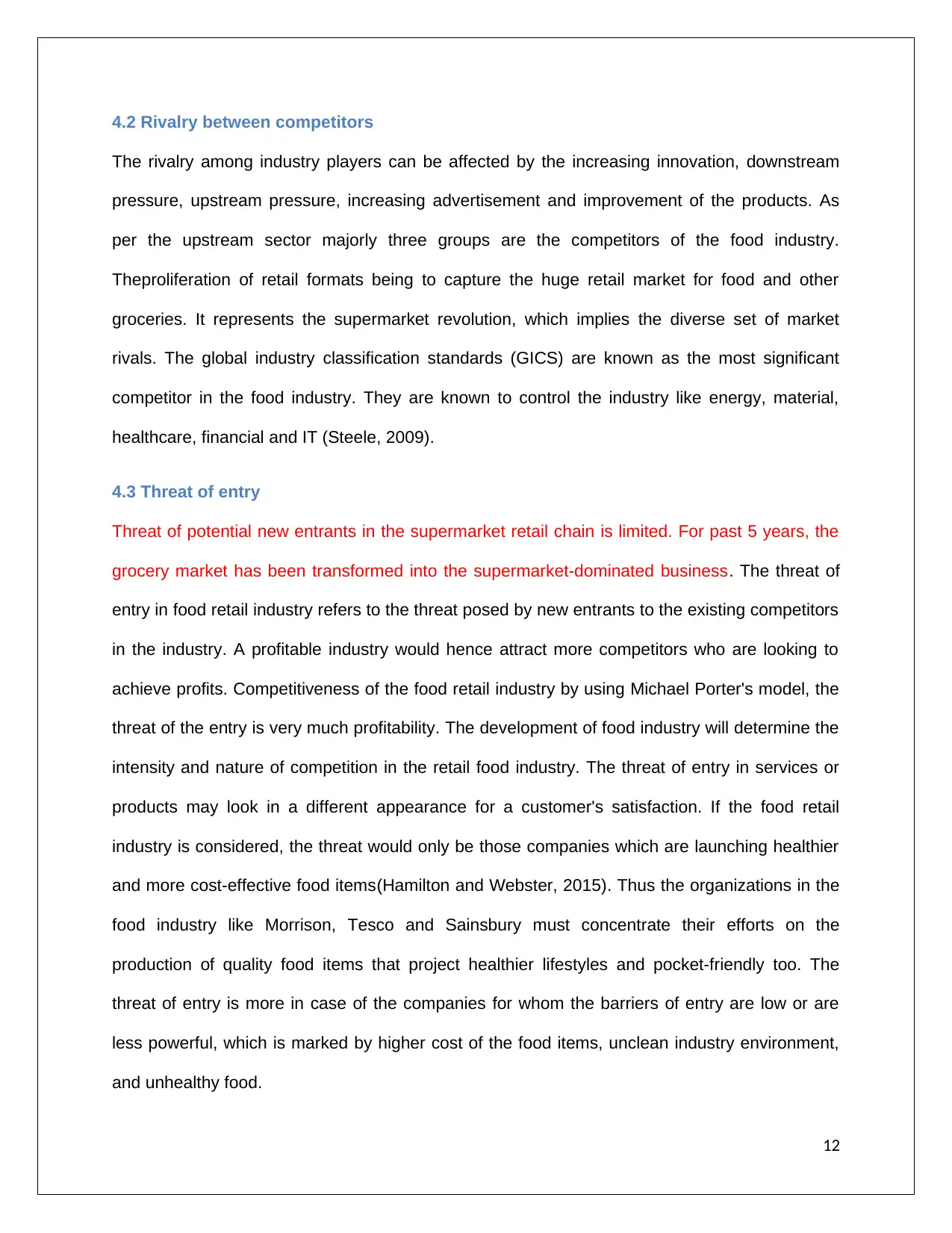
4.2 Rivalry between competitors
The rivalry among industry players can be affected by the increasing innovation, downstream
pressure, upstream pressure, increasing advertisement and improvement of the products. As
per the upstream sector majorly three groups are the competitors of the food industry.
Theproliferation of retail formats being to capture the huge retail market for food and other
groceries. It represents the supermarket revolution, which implies the diverse set of market
rivals. The global industry classification standards (GICS) are known as the most significant
competitor in the food industry. They are known to control the industry like energy, material,
healthcare, financial and IT (Steele, 2009).
4.3 Threat of entry
Threat of potential new entrants in the supermarket retail chain is limited. For past 5 years, the
grocery market has been transformed into the supermarket-dominated business. The threat of
entry in food retail industry refers to the threat posed by new entrants to the existing competitors
in the industry. A profitable industry would hence attract more competitors who are looking to
achieve profits. Competitiveness of the food retail industry by using Michael Porter's model, the
threat of the entry is very much profitability. The development of food industry will determine the
intensity and nature of competition in the retail food industry. The threat of entry in services or
products may look in a different appearance for a customer's satisfaction. If the food retail
industry is considered, the threat would only be those companies which are launching healthier
and more cost-effective food items(Hamilton and Webster, 2015). Thus the organizations in the
food industry like Morrison, Tesco and Sainsbury must concentrate their efforts on the
production of quality food items that project healthier lifestyles and pocket-friendly too. The
threat of entry is more in case of the companies for whom the barriers of entry are low or are
less powerful, which is marked by higher cost of the food items, unclean industry environment,
and unhealthy food.
12
The rivalry among industry players can be affected by the increasing innovation, downstream
pressure, upstream pressure, increasing advertisement and improvement of the products. As
per the upstream sector majorly three groups are the competitors of the food industry.
Theproliferation of retail formats being to capture the huge retail market for food and other
groceries. It represents the supermarket revolution, which implies the diverse set of market
rivals. The global industry classification standards (GICS) are known as the most significant
competitor in the food industry. They are known to control the industry like energy, material,
healthcare, financial and IT (Steele, 2009).
4.3 Threat of entry
Threat of potential new entrants in the supermarket retail chain is limited. For past 5 years, the
grocery market has been transformed into the supermarket-dominated business. The threat of
entry in food retail industry refers to the threat posed by new entrants to the existing competitors
in the industry. A profitable industry would hence attract more competitors who are looking to
achieve profits. Competitiveness of the food retail industry by using Michael Porter's model, the
threat of the entry is very much profitability. The development of food industry will determine the
intensity and nature of competition in the retail food industry. The threat of entry in services or
products may look in a different appearance for a customer's satisfaction. If the food retail
industry is considered, the threat would only be those companies which are launching healthier
and more cost-effective food items(Hamilton and Webster, 2015). Thus the organizations in the
food industry like Morrison, Tesco and Sainsbury must concentrate their efforts on the
production of quality food items that project healthier lifestyles and pocket-friendly too. The
threat of entry is more in case of the companies for whom the barriers of entry are low or are
less powerful, which is marked by higher cost of the food items, unclean industry environment,
and unhealthy food.
12
Secure Best Marks with AI Grader
Need help grading? Try our AI Grader for instant feedback on your assignments.
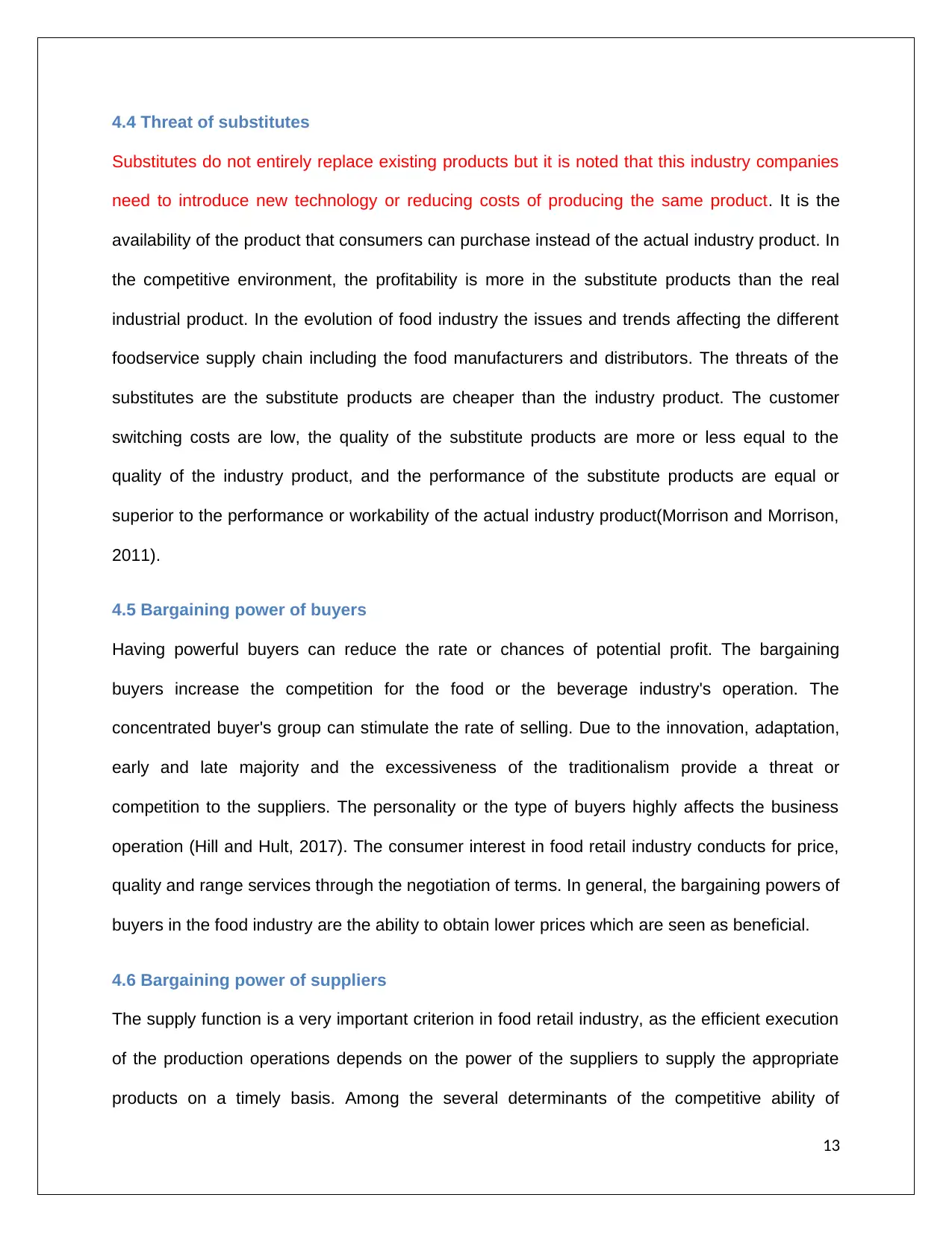
4.4 Threat of substitutes
Substitutes do not entirely replace existing products but it is noted that this industry companies
need to introduce new technology or reducing costs of producing the same product. It is the
availability of the product that consumers can purchase instead of the actual industry product. In
the competitive environment, the profitability is more in the substitute products than the real
industrial product. In the evolution of food industry the issues and trends affecting the different
foodservice supply chain including the food manufacturers and distributors. The threats of the
substitutes are the substitute products are cheaper than the industry product. The customer
switching costs are low, the quality of the substitute products are more or less equal to the
quality of the industry product, and the performance of the substitute products are equal or
superior to the performance or workability of the actual industry product(Morrison and Morrison,
2011).
4.5 Bargaining power of buyers
Having powerful buyers can reduce the rate or chances of potential profit. The bargaining
buyers increase the competition for the food or the beverage industry's operation. The
concentrated buyer's group can stimulate the rate of selling. Due to the innovation, adaptation,
early and late majority and the excessiveness of the traditionalism provide a threat or
competition to the suppliers. The personality or the type of buyers highly affects the business
operation (Hill and Hult, 2017). The consumer interest in food retail industry conducts for price,
quality and range services through the negotiation of terms. In general, the bargaining powers of
buyers in the food industry are the ability to obtain lower prices which are seen as beneficial.
4.6 Bargaining power of suppliers
The supply function is a very important criterion in food retail industry, as the efficient execution
of the production operations depends on the power of the suppliers to supply the appropriate
products on a timely basis. Among the several determinants of the competitive ability of
13
Substitutes do not entirely replace existing products but it is noted that this industry companies
need to introduce new technology or reducing costs of producing the same product. It is the
availability of the product that consumers can purchase instead of the actual industry product. In
the competitive environment, the profitability is more in the substitute products than the real
industrial product. In the evolution of food industry the issues and trends affecting the different
foodservice supply chain including the food manufacturers and distributors. The threats of the
substitutes are the substitute products are cheaper than the industry product. The customer
switching costs are low, the quality of the substitute products are more or less equal to the
quality of the industry product, and the performance of the substitute products are equal or
superior to the performance or workability of the actual industry product(Morrison and Morrison,
2011).
4.5 Bargaining power of buyers
Having powerful buyers can reduce the rate or chances of potential profit. The bargaining
buyers increase the competition for the food or the beverage industry's operation. The
concentrated buyer's group can stimulate the rate of selling. Due to the innovation, adaptation,
early and late majority and the excessiveness of the traditionalism provide a threat or
competition to the suppliers. The personality or the type of buyers highly affects the business
operation (Hill and Hult, 2017). The consumer interest in food retail industry conducts for price,
quality and range services through the negotiation of terms. In general, the bargaining powers of
buyers in the food industry are the ability to obtain lower prices which are seen as beneficial.
4.6 Bargaining power of suppliers
The supply function is a very important criterion in food retail industry, as the efficient execution
of the production operations depends on the power of the suppliers to supply the appropriate
products on a timely basis. Among the several determinants of the competitive ability of
13
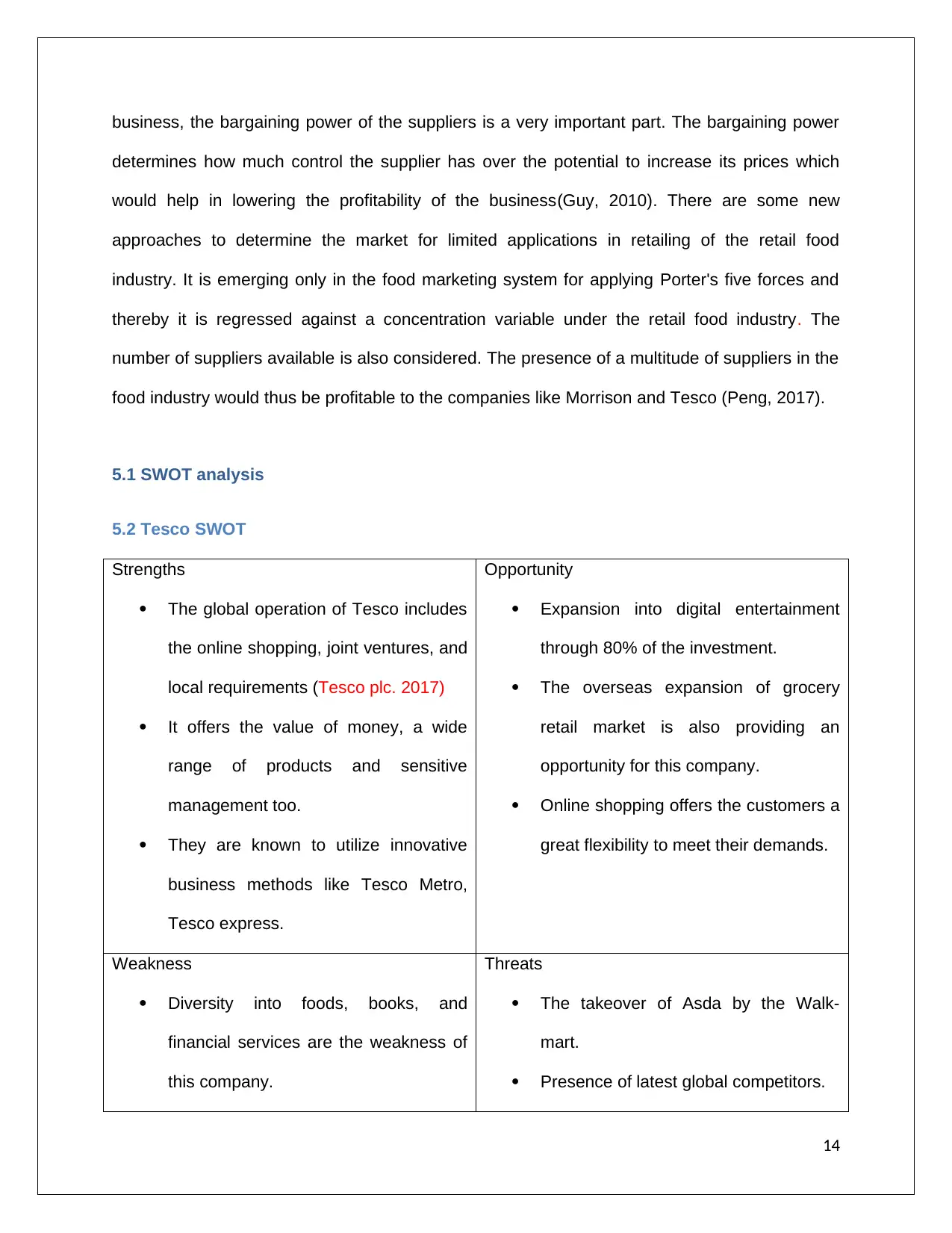
business, the bargaining power of the suppliers is a very important part. The bargaining power
determines how much control the supplier has over the potential to increase its prices which
would help in lowering the profitability of the business(Guy, 2010). There are some new
approaches to determine the market for limited applications in retailing of the retail food
industry. It is emerging only in the food marketing system for applying Porter's five forces and
thereby it is regressed against a concentration variable under the retail food industry. The
number of suppliers available is also considered. The presence of a multitude of suppliers in the
food industry would thus be profitable to the companies like Morrison and Tesco (Peng, 2017).
5.1 SWOT analysis
5.2 Tesco SWOT
Strengths
The global operation of Tesco includes
the online shopping, joint ventures, and
local requirements (Tesco plc. 2017)
It offers the value of money, a wide
range of products and sensitive
management too.
They are known to utilize innovative
business methods like Tesco Metro,
Tesco express.
Opportunity
Expansion into digital entertainment
through 80% of the investment.
The overseas expansion of grocery
retail market is also providing an
opportunity for this company.
Online shopping offers the customers a
great flexibility to meet their demands.
Weakness
Diversity into foods, books, and
financial services are the weakness of
this company.
Threats
The takeover of Asda by the Walk-
mart.
Presence of latest global competitors.
14
determines how much control the supplier has over the potential to increase its prices which
would help in lowering the profitability of the business(Guy, 2010). There are some new
approaches to determine the market for limited applications in retailing of the retail food
industry. It is emerging only in the food marketing system for applying Porter's five forces and
thereby it is regressed against a concentration variable under the retail food industry. The
number of suppliers available is also considered. The presence of a multitude of suppliers in the
food industry would thus be profitable to the companies like Morrison and Tesco (Peng, 2017).
5.1 SWOT analysis
5.2 Tesco SWOT
Strengths
The global operation of Tesco includes
the online shopping, joint ventures, and
local requirements (Tesco plc. 2017)
It offers the value of money, a wide
range of products and sensitive
management too.
They are known to utilize innovative
business methods like Tesco Metro,
Tesco express.
Opportunity
Expansion into digital entertainment
through 80% of the investment.
The overseas expansion of grocery
retail market is also providing an
opportunity for this company.
Online shopping offers the customers a
great flexibility to meet their demands.
Weakness
Diversity into foods, books, and
financial services are the weakness of
this company.
Threats
The takeover of Asda by the Walk-
mart.
Presence of latest global competitors.
14
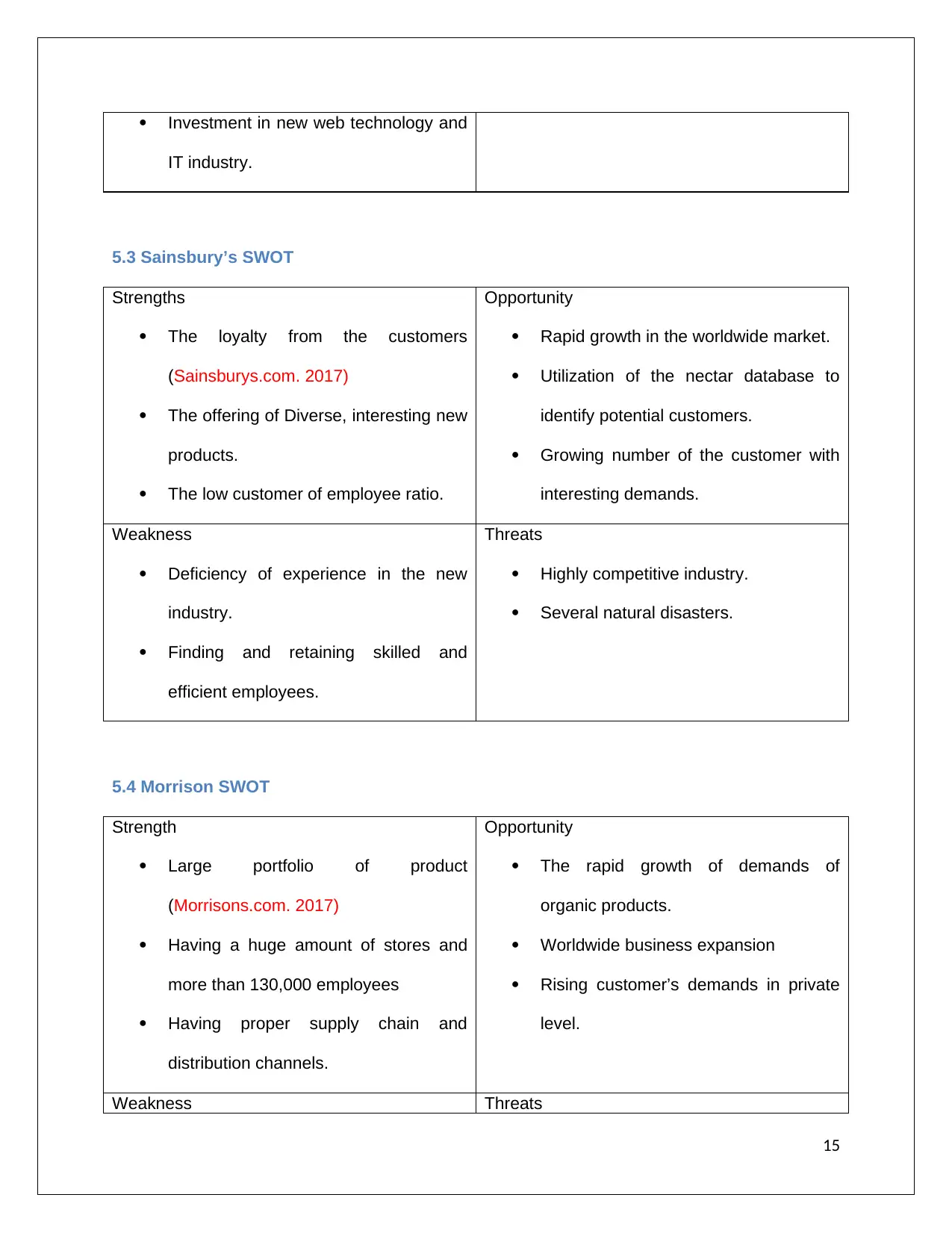
Investment in new web technology and
IT industry.
5.3 Sainsbury’s SWOT
Strengths
The loyalty from the customers
(Sainsburys.com. 2017)
The offering of Diverse, interesting new
products.
The low customer of employee ratio.
Opportunity
Rapid growth in the worldwide market.
Utilization of the nectar database to
identify potential customers.
Growing number of the customer with
interesting demands.
Weakness
Deficiency of experience in the new
industry.
Finding and retaining skilled and
efficient employees.
Threats
Highly competitive industry.
Several natural disasters.
5.4 Morrison SWOT
Strength
Large portfolio of product
(Morrisons.com. 2017)
Having a huge amount of stores and
more than 130,000 employees
Having proper supply chain and
distribution channels.
Opportunity
The rapid growth of demands of
organic products.
Worldwide business expansion
Rising customer’s demands in private
level.
Weakness Threats
15
IT industry.
5.3 Sainsbury’s SWOT
Strengths
The loyalty from the customers
(Sainsburys.com. 2017)
The offering of Diverse, interesting new
products.
The low customer of employee ratio.
Opportunity
Rapid growth in the worldwide market.
Utilization of the nectar database to
identify potential customers.
Growing number of the customer with
interesting demands.
Weakness
Deficiency of experience in the new
industry.
Finding and retaining skilled and
efficient employees.
Threats
Highly competitive industry.
Several natural disasters.
5.4 Morrison SWOT
Strength
Large portfolio of product
(Morrisons.com. 2017)
Having a huge amount of stores and
more than 130,000 employees
Having proper supply chain and
distribution channels.
Opportunity
The rapid growth of demands of
organic products.
Worldwide business expansion
Rising customer’s demands in private
level.
Weakness Threats
15
Paraphrase This Document
Need a fresh take? Get an instant paraphrase of this document with our AI Paraphraser
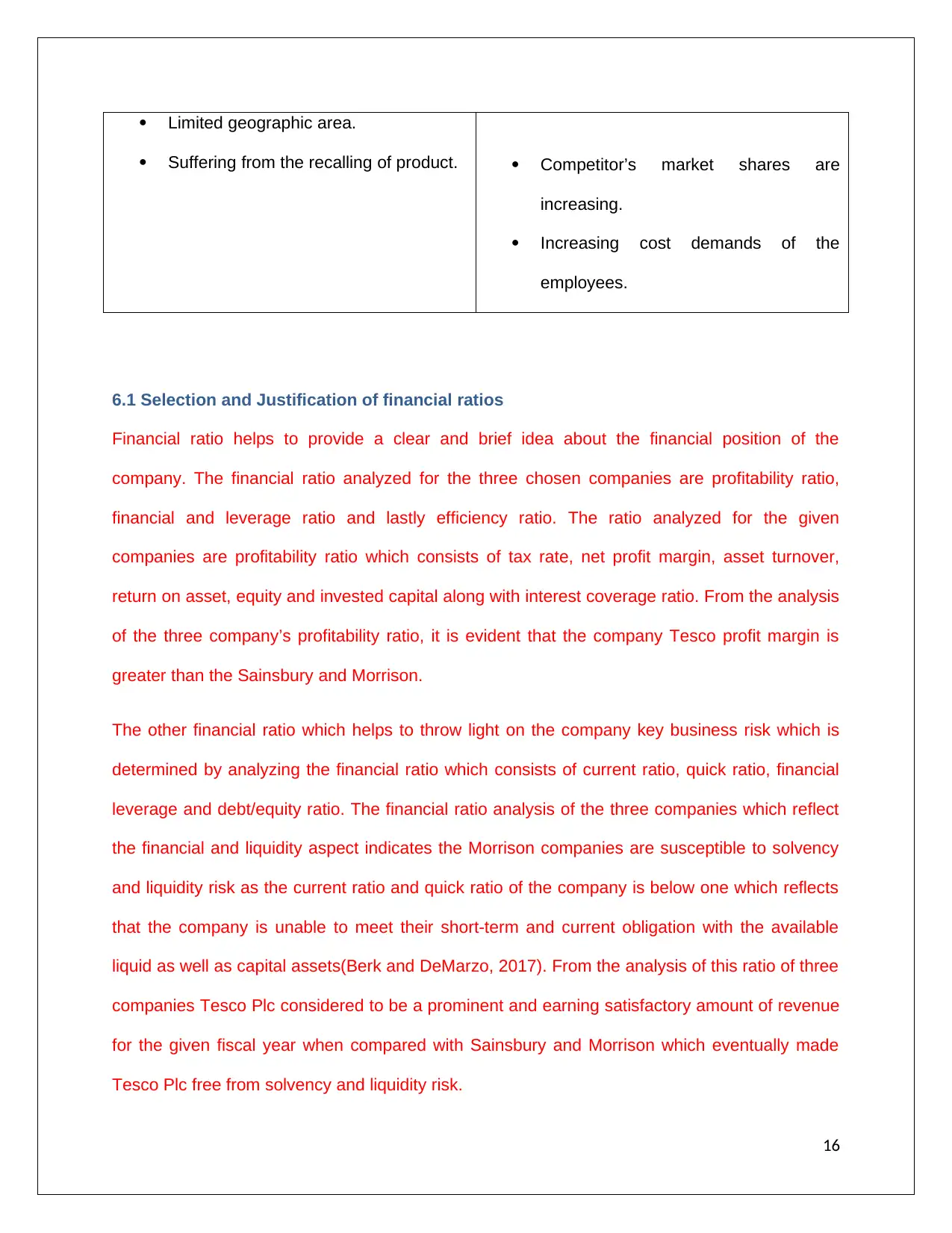
Limited geographic area.
Suffering from the recalling of product. Competitor’s market shares are
increasing.
Increasing cost demands of the
employees.
6.1 Selection and Justification of financial ratios
Financial ratio helps to provide a clear and brief idea about the financial position of the
company. The financial ratio analyzed for the three chosen companies are profitability ratio,
financial and leverage ratio and lastly efficiency ratio. The ratio analyzed for the given
companies are profitability ratio which consists of tax rate, net profit margin, asset turnover,
return on asset, equity and invested capital along with interest coverage ratio. From the analysis
of the three company’s profitability ratio, it is evident that the company Tesco profit margin is
greater than the Sainsbury and Morrison.
The other financial ratio which helps to throw light on the company key business risk which is
determined by analyzing the financial ratio which consists of current ratio, quick ratio, financial
leverage and debt/equity ratio. The financial ratio analysis of the three companies which reflect
the financial and liquidity aspect indicates the Morrison companies are susceptible to solvency
and liquidity risk as the current ratio and quick ratio of the company is below one which reflects
that the company is unable to meet their short-term and current obligation with the available
liquid as well as capital assets(Berk and DeMarzo, 2017). From the analysis of this ratio of three
companies Tesco Plc considered to be a prominent and earning satisfactory amount of revenue
for the given fiscal year when compared with Sainsbury and Morrison which eventually made
Tesco Plc free from solvency and liquidity risk.
16
Suffering from the recalling of product. Competitor’s market shares are
increasing.
Increasing cost demands of the
employees.
6.1 Selection and Justification of financial ratios
Financial ratio helps to provide a clear and brief idea about the financial position of the
company. The financial ratio analyzed for the three chosen companies are profitability ratio,
financial and leverage ratio and lastly efficiency ratio. The ratio analyzed for the given
companies are profitability ratio which consists of tax rate, net profit margin, asset turnover,
return on asset, equity and invested capital along with interest coverage ratio. From the analysis
of the three company’s profitability ratio, it is evident that the company Tesco profit margin is
greater than the Sainsbury and Morrison.
The other financial ratio which helps to throw light on the company key business risk which is
determined by analyzing the financial ratio which consists of current ratio, quick ratio, financial
leverage and debt/equity ratio. The financial ratio analysis of the three companies which reflect
the financial and liquidity aspect indicates the Morrison companies are susceptible to solvency
and liquidity risk as the current ratio and quick ratio of the company is below one which reflects
that the company is unable to meet their short-term and current obligation with the available
liquid as well as capital assets(Berk and DeMarzo, 2017). From the analysis of this ratio of three
companies Tesco Plc considered to be a prominent and earning satisfactory amount of revenue
for the given fiscal year when compared with Sainsbury and Morrison which eventually made
Tesco Plc free from solvency and liquidity risk.
16
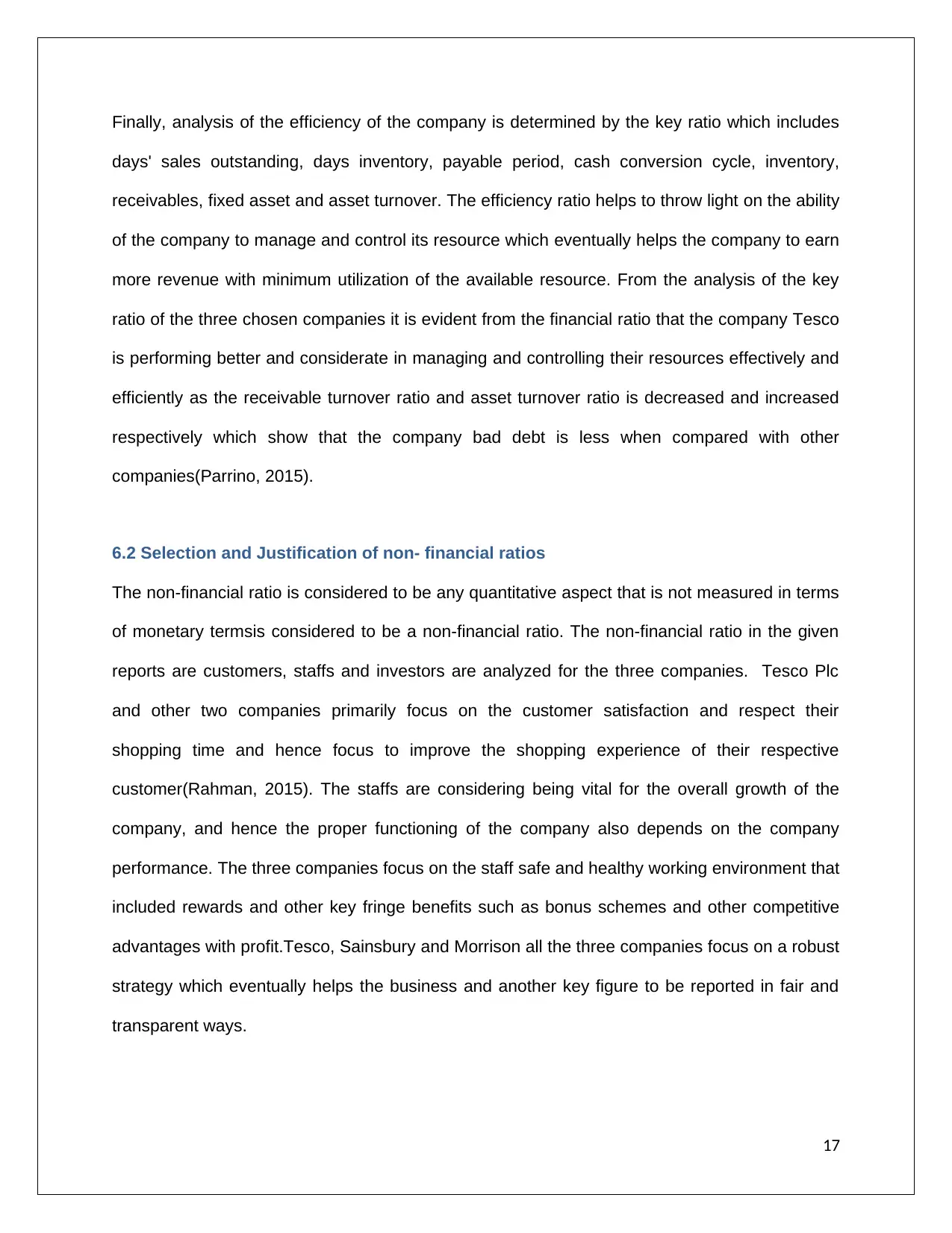
Finally, analysis of the efficiency of the company is determined by the key ratio which includes
days' sales outstanding, days inventory, payable period, cash conversion cycle, inventory,
receivables, fixed asset and asset turnover. The efficiency ratio helps to throw light on the ability
of the company to manage and control its resource which eventually helps the company to earn
more revenue with minimum utilization of the available resource. From the analysis of the key
ratio of the three chosen companies it is evident from the financial ratio that the company Tesco
is performing better and considerate in managing and controlling their resources effectively and
efficiently as the receivable turnover ratio and asset turnover ratio is decreased and increased
respectively which show that the company bad debt is less when compared with other
companies(Parrino, 2015).
6.2 Selection and Justification of non- financial ratios
The non-financial ratio is considered to be any quantitative aspect that is not measured in terms
of monetary termsis considered to be a non-financial ratio. The non-financial ratio in the given
reports are customers, staffs and investors are analyzed for the three companies. Tesco Plc
and other two companies primarily focus on the customer satisfaction and respect their
shopping time and hence focus to improve the shopping experience of their respective
customer(Rahman, 2015). The staffs are considering being vital for the overall growth of the
company, and hence the proper functioning of the company also depends on the company
performance. The three companies focus on the staff safe and healthy working environment that
included rewards and other key fringe benefits such as bonus schemes and other competitive
advantages with profit.Tesco, Sainsbury and Morrison all the three companies focus on a robust
strategy which eventually helps the business and another key figure to be reported in fair and
transparent ways.
17
days' sales outstanding, days inventory, payable period, cash conversion cycle, inventory,
receivables, fixed asset and asset turnover. The efficiency ratio helps to throw light on the ability
of the company to manage and control its resource which eventually helps the company to earn
more revenue with minimum utilization of the available resource. From the analysis of the key
ratio of the three chosen companies it is evident from the financial ratio that the company Tesco
is performing better and considerate in managing and controlling their resources effectively and
efficiently as the receivable turnover ratio and asset turnover ratio is decreased and increased
respectively which show that the company bad debt is less when compared with other
companies(Parrino, 2015).
6.2 Selection and Justification of non- financial ratios
The non-financial ratio is considered to be any quantitative aspect that is not measured in terms
of monetary termsis considered to be a non-financial ratio. The non-financial ratio in the given
reports are customers, staffs and investors are analyzed for the three companies. Tesco Plc
and other two companies primarily focus on the customer satisfaction and respect their
shopping time and hence focus to improve the shopping experience of their respective
customer(Rahman, 2015). The staffs are considering being vital for the overall growth of the
company, and hence the proper functioning of the company also depends on the company
performance. The three companies focus on the staff safe and healthy working environment that
included rewards and other key fringe benefits such as bonus schemes and other competitive
advantages with profit.Tesco, Sainsbury and Morrison all the three companies focus on a robust
strategy which eventually helps the business and another key figure to be reported in fair and
transparent ways.
17
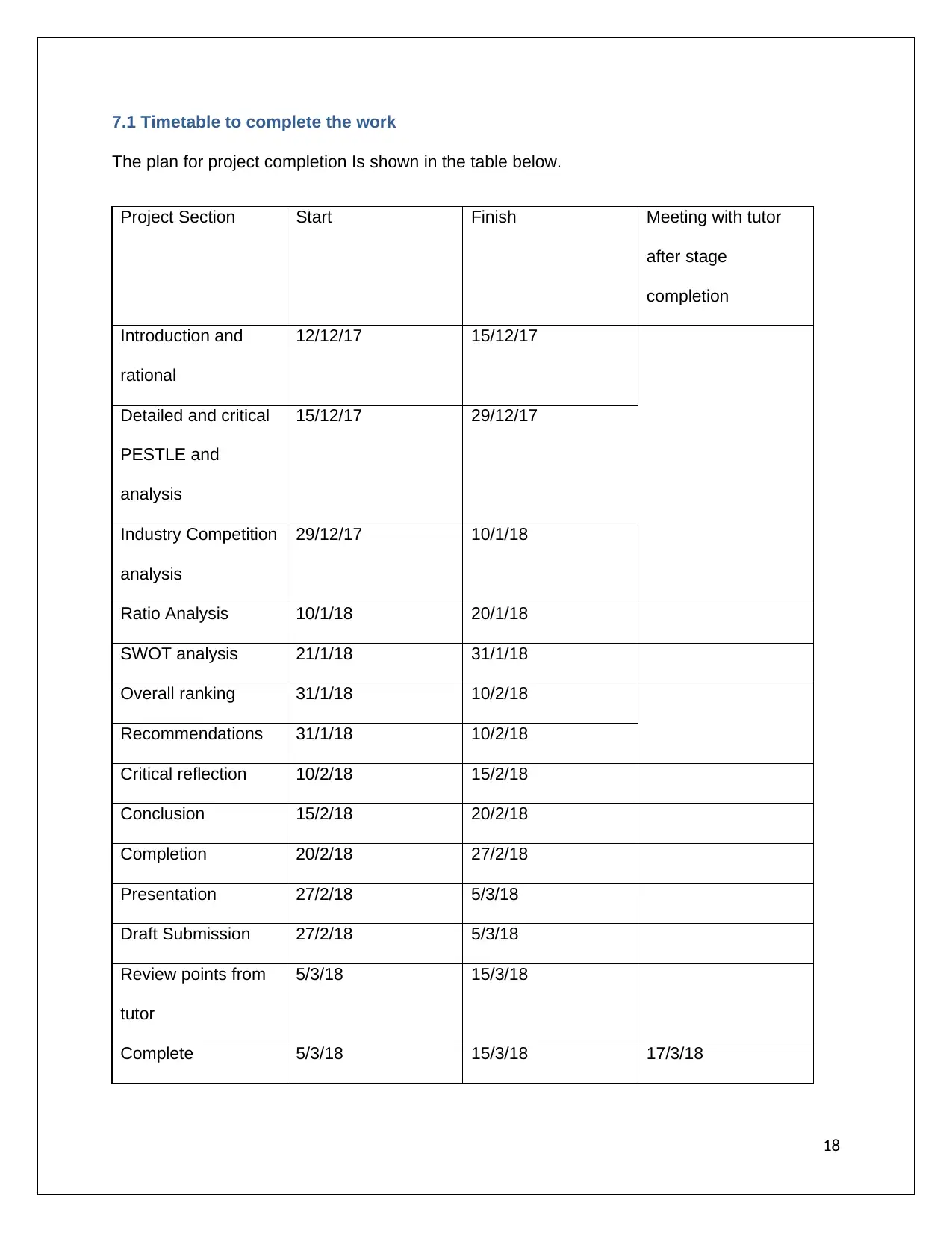
7.1 Timetable to complete the work
The plan for project completion Is shown in the table below.
Project Section Start Finish Meeting with tutor
after stage
completion
Introduction and
rational
12/12/17 15/12/17
Detailed and critical
PESTLE and
analysis
15/12/17 29/12/17
Industry Competition
analysis
29/12/17 10/1/18
Ratio Analysis 10/1/18 20/1/18
SWOT analysis 21/1/18 31/1/18
Overall ranking 31/1/18 10/2/18
Recommendations 31/1/18 10/2/18
Critical reflection 10/2/18 15/2/18
Conclusion 15/2/18 20/2/18
Completion 20/2/18 27/2/18
Presentation 27/2/18 5/3/18
Draft Submission 27/2/18 5/3/18
Review points from
tutor
5/3/18 15/3/18
Complete 5/3/18 15/3/18 17/3/18
18
The plan for project completion Is shown in the table below.
Project Section Start Finish Meeting with tutor
after stage
completion
Introduction and
rational
12/12/17 15/12/17
Detailed and critical
PESTLE and
analysis
15/12/17 29/12/17
Industry Competition
analysis
29/12/17 10/1/18
Ratio Analysis 10/1/18 20/1/18
SWOT analysis 21/1/18 31/1/18
Overall ranking 31/1/18 10/2/18
Recommendations 31/1/18 10/2/18
Critical reflection 10/2/18 15/2/18
Conclusion 15/2/18 20/2/18
Completion 20/2/18 27/2/18
Presentation 27/2/18 5/3/18
Draft Submission 27/2/18 5/3/18
Review points from
tutor
5/3/18 15/3/18
Complete 5/3/18 15/3/18 17/3/18
18
Secure Best Marks with AI Grader
Need help grading? Try our AI Grader for instant feedback on your assignments.
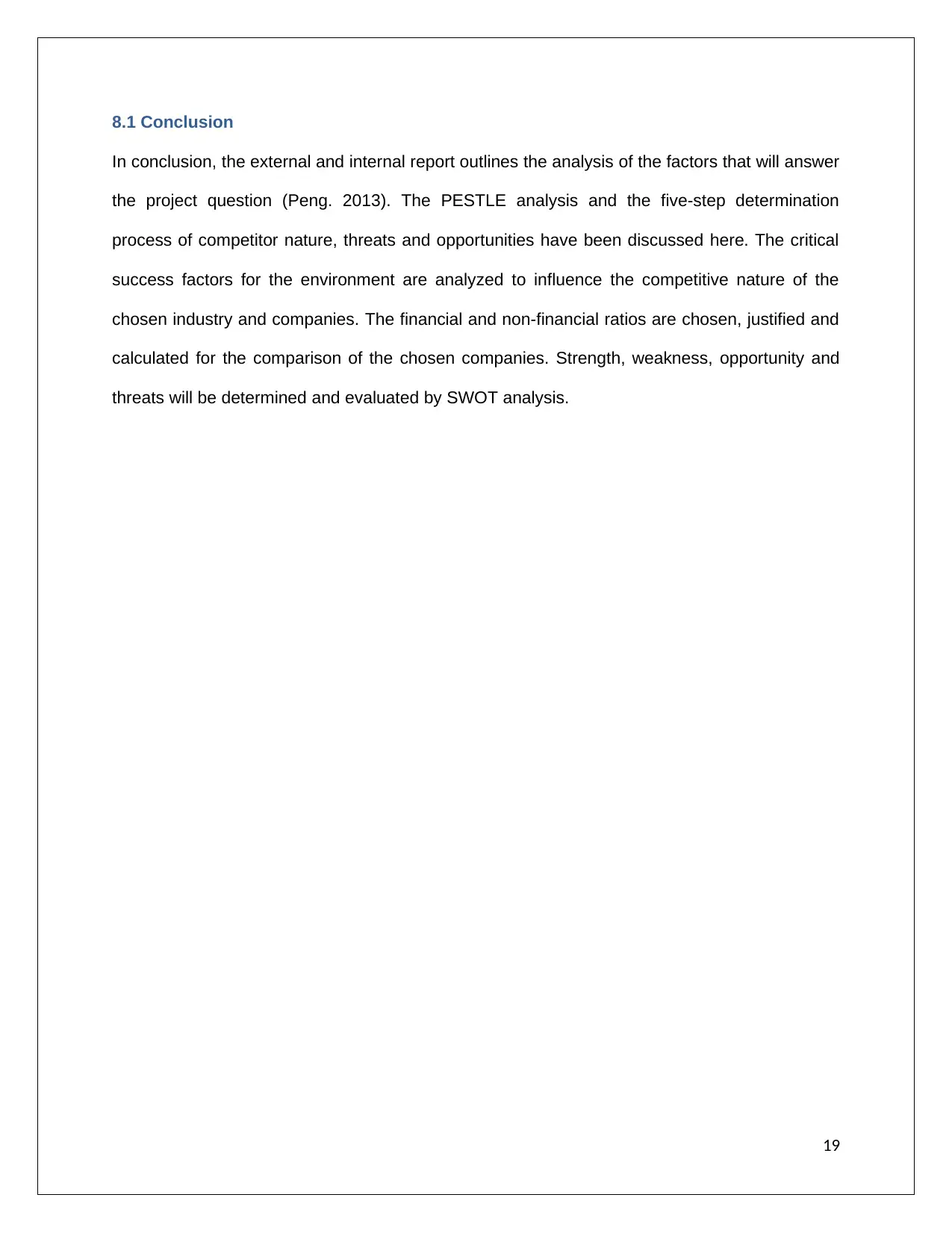
8.1 Conclusion
In conclusion, the external and internal report outlines the analysis of the factors that will answer
the project question (Peng. 2013). The PESTLE analysis and the five-step determination
process of competitor nature, threats and opportunities have been discussed here. The critical
success factors for the environment are analyzed to influence the competitive nature of the
chosen industry and companies. The financial and non-financial ratios are chosen, justified and
calculated for the comparison of the chosen companies. Strength, weakness, opportunity and
threats will be determined and evaluated by SWOT analysis.
19
In conclusion, the external and internal report outlines the analysis of the factors that will answer
the project question (Peng. 2013). The PESTLE analysis and the five-step determination
process of competitor nature, threats and opportunities have been discussed here. The critical
success factors for the environment are analyzed to influence the competitive nature of the
chosen industry and companies. The financial and non-financial ratios are chosen, justified and
calculated for the comparison of the chosen companies. Strength, weakness, opportunity and
threats will be determined and evaluated by SWOT analysis.
19
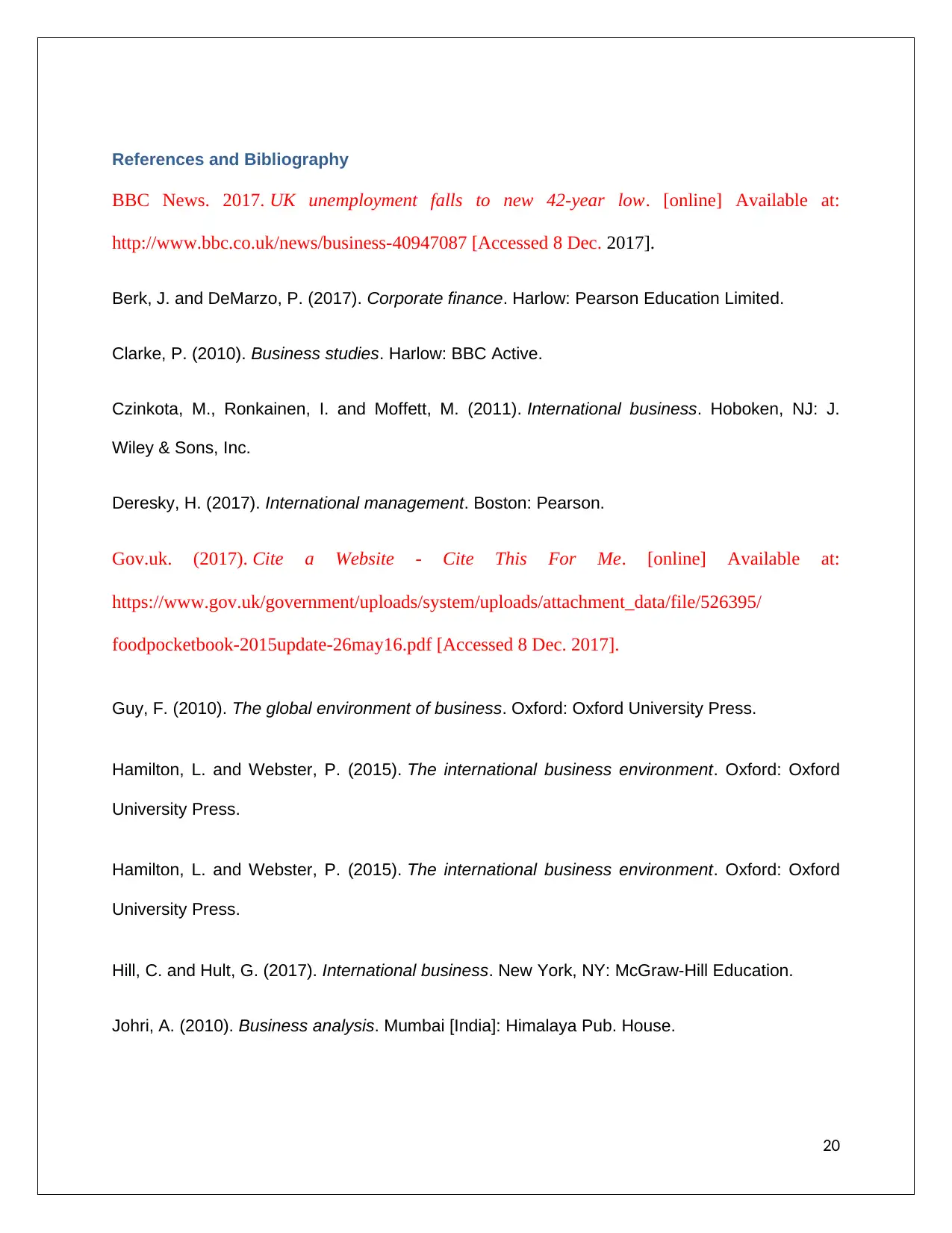
References and Bibliography
BBC News. 2017. UK unemployment falls to new 42-year low. [online] Available at:
http://www.bbc.co.uk/news/business-40947087 [Accessed 8 Dec. 2017].
Berk, J. and DeMarzo, P. (2017). Corporate finance. Harlow: Pearson Education Limited.
Clarke, P. (2010). Business studies. Harlow: BBC Active.
Czinkota, M., Ronkainen, I. and Moffett, M. (2011). International business. Hoboken, NJ: J.
Wiley & Sons, Inc.
Deresky, H. (2017). International management. Boston: Pearson.
Gov.uk. (2017). Cite a Website - Cite This For Me. [online] Available at:
https://www.gov.uk/government/uploads/system/uploads/attachment_data/file/526395/
foodpocketbook-2015update-26may16.pdf [Accessed 8 Dec. 2017].
Guy, F. (2010). The global environment of business. Oxford: Oxford University Press.
Hamilton, L. and Webster, P. (2015). The international business environment. Oxford: Oxford
University Press.
Hamilton, L. and Webster, P. (2015). The international business environment. Oxford: Oxford
University Press.
Hill, C. and Hult, G. (2017). International business. New York, NY: McGraw-Hill Education.
Johri, A. (2010). Business analysis. Mumbai [India]: Himalaya Pub. House.
20
BBC News. 2017. UK unemployment falls to new 42-year low. [online] Available at:
http://www.bbc.co.uk/news/business-40947087 [Accessed 8 Dec. 2017].
Berk, J. and DeMarzo, P. (2017). Corporate finance. Harlow: Pearson Education Limited.
Clarke, P. (2010). Business studies. Harlow: BBC Active.
Czinkota, M., Ronkainen, I. and Moffett, M. (2011). International business. Hoboken, NJ: J.
Wiley & Sons, Inc.
Deresky, H. (2017). International management. Boston: Pearson.
Gov.uk. (2017). Cite a Website - Cite This For Me. [online] Available at:
https://www.gov.uk/government/uploads/system/uploads/attachment_data/file/526395/
foodpocketbook-2015update-26may16.pdf [Accessed 8 Dec. 2017].
Guy, F. (2010). The global environment of business. Oxford: Oxford University Press.
Hamilton, L. and Webster, P. (2015). The international business environment. Oxford: Oxford
University Press.
Hamilton, L. and Webster, P. (2015). The international business environment. Oxford: Oxford
University Press.
Hill, C. and Hult, G. (2017). International business. New York, NY: McGraw-Hill Education.
Johri, A. (2010). Business analysis. Mumbai [India]: Himalaya Pub. House.
20
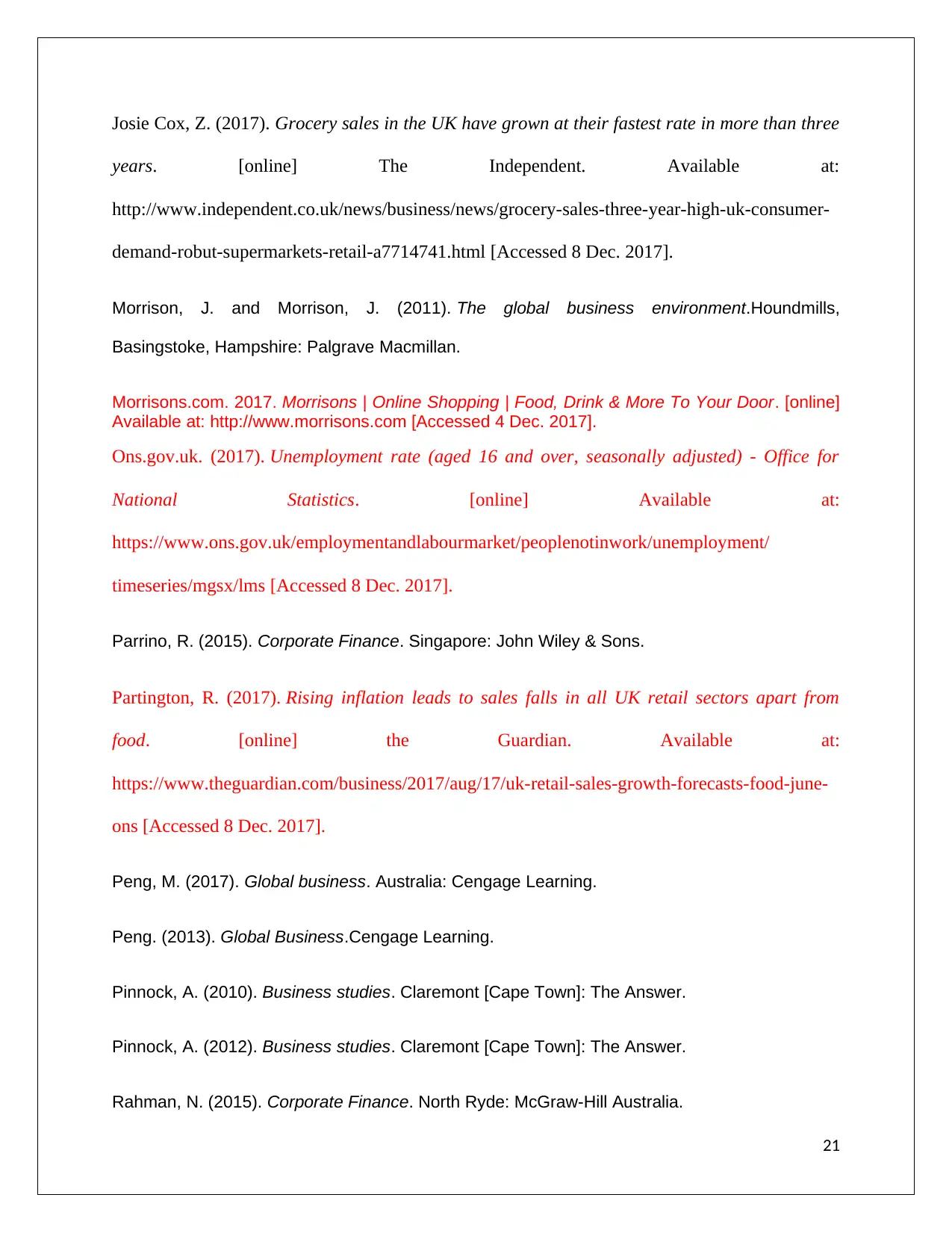
Josie Cox, Z. (2017). Grocery sales in the UK have grown at their fastest rate in more than three
years. [online] The Independent. Available at:
http://www.independent.co.uk/news/business/news/grocery-sales-three-year-high-uk-consumer-
demand-robut-supermarkets-retail-a7714741.html [Accessed 8 Dec. 2017].
Morrison, J. and Morrison, J. (2011). The global business environment.Houndmills,
Basingstoke, Hampshire: Palgrave Macmillan.
Morrisons.com. 2017. Morrisons | Online Shopping | Food, Drink & More To Your Door. [online]
Available at: http://www.morrisons.com [Accessed 4 Dec. 2017].
Ons.gov.uk. (2017). Unemployment rate (aged 16 and over, seasonally adjusted) - Office for
National Statistics. [online] Available at:
https://www.ons.gov.uk/employmentandlabourmarket/peoplenotinwork/unemployment/
timeseries/mgsx/lms [Accessed 8 Dec. 2017].
Parrino, R. (2015). Corporate Finance. Singapore: John Wiley & Sons.
Partington, R. (2017). Rising inflation leads to sales falls in all UK retail sectors apart from
food. [online] the Guardian. Available at:
https://www.theguardian.com/business/2017/aug/17/uk-retail-sales-growth-forecasts-food-june-
ons [Accessed 8 Dec. 2017].
Peng, M. (2017). Global business. Australia: Cengage Learning.
Peng. (2013). Global Business.Cengage Learning.
Pinnock, A. (2010). Business studies. Claremont [Cape Town]: The Answer.
Pinnock, A. (2012). Business studies. Claremont [Cape Town]: The Answer.
Rahman, N. (2015). Corporate Finance. North Ryde: McGraw-Hill Australia.
21
years. [online] The Independent. Available at:
http://www.independent.co.uk/news/business/news/grocery-sales-three-year-high-uk-consumer-
demand-robut-supermarkets-retail-a7714741.html [Accessed 8 Dec. 2017].
Morrison, J. and Morrison, J. (2011). The global business environment.Houndmills,
Basingstoke, Hampshire: Palgrave Macmillan.
Morrisons.com. 2017. Morrisons | Online Shopping | Food, Drink & More To Your Door. [online]
Available at: http://www.morrisons.com [Accessed 4 Dec. 2017].
Ons.gov.uk. (2017). Unemployment rate (aged 16 and over, seasonally adjusted) - Office for
National Statistics. [online] Available at:
https://www.ons.gov.uk/employmentandlabourmarket/peoplenotinwork/unemployment/
timeseries/mgsx/lms [Accessed 8 Dec. 2017].
Parrino, R. (2015). Corporate Finance. Singapore: John Wiley & Sons.
Partington, R. (2017). Rising inflation leads to sales falls in all UK retail sectors apart from
food. [online] the Guardian. Available at:
https://www.theguardian.com/business/2017/aug/17/uk-retail-sales-growth-forecasts-food-june-
ons [Accessed 8 Dec. 2017].
Peng, M. (2017). Global business. Australia: Cengage Learning.
Peng. (2013). Global Business.Cengage Learning.
Pinnock, A. (2010). Business studies. Claremont [Cape Town]: The Answer.
Pinnock, A. (2012). Business studies. Claremont [Cape Town]: The Answer.
Rahman, N. (2015). Corporate Finance. North Ryde: McGraw-Hill Australia.
21
Paraphrase This Document
Need a fresh take? Get an instant paraphrase of this document with our AI Paraphraser
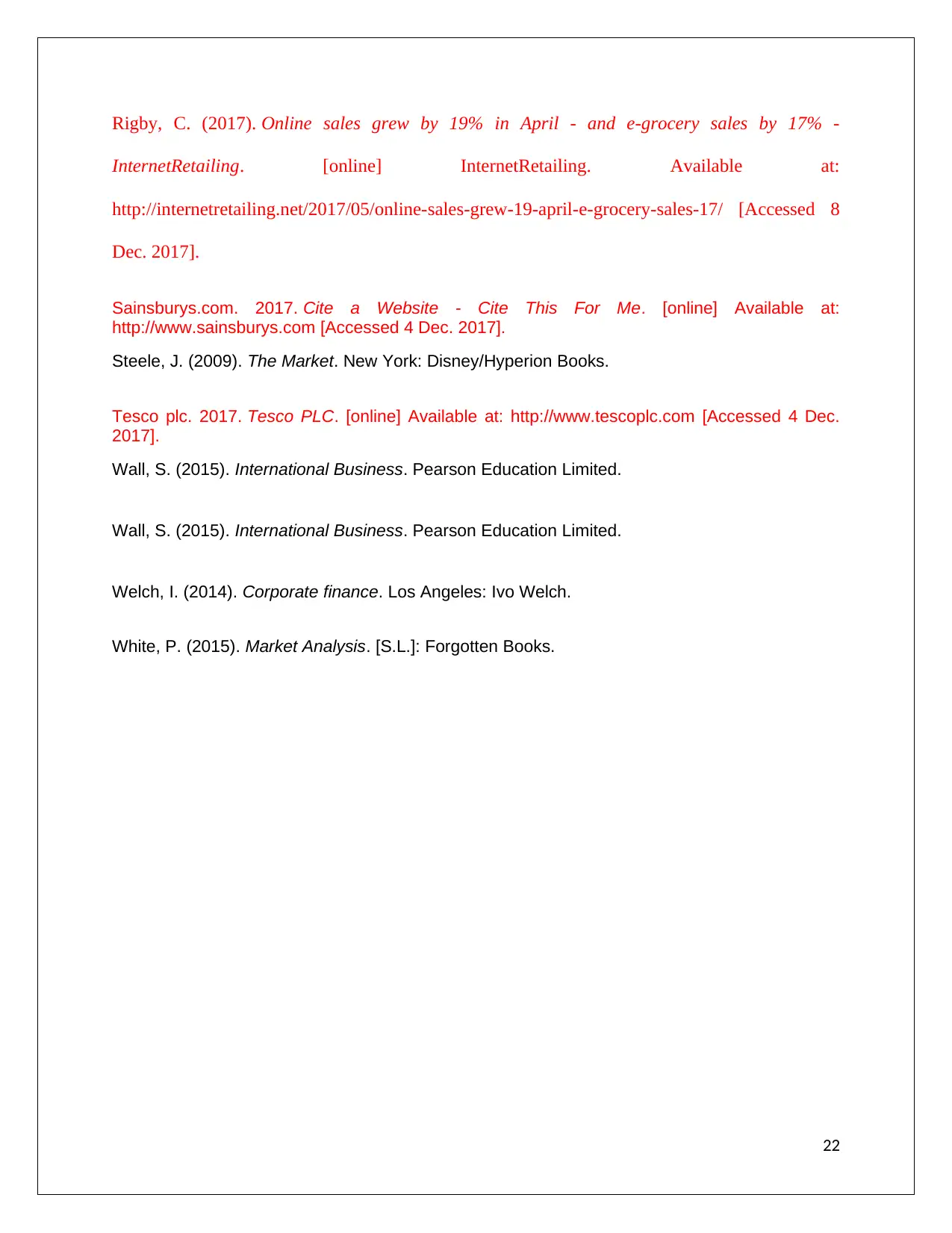
Rigby, C. (2017). Online sales grew by 19% in April - and e-grocery sales by 17% -
InternetRetailing. [online] InternetRetailing. Available at:
http://internetretailing.net/2017/05/online-sales-grew-19-april-e-grocery-sales-17/ [Accessed 8
Dec. 2017].
Sainsburys.com. 2017. Cite a Website - Cite This For Me. [online] Available at:
http://www.sainsburys.com [Accessed 4 Dec. 2017].
Steele, J. (2009). The Market. New York: Disney/Hyperion Books.
Tesco plc. 2017. Tesco PLC. [online] Available at: http://www.tescoplc.com [Accessed 4 Dec.
2017].
Wall, S. (2015). International Business. Pearson Education Limited.
Wall, S. (2015). International Business. Pearson Education Limited.
Welch, I. (2014). Corporate finance. Los Angeles: Ivo Welch.
White, P. (2015). Market Analysis. [S.L.]: Forgotten Books.
22
InternetRetailing. [online] InternetRetailing. Available at:
http://internetretailing.net/2017/05/online-sales-grew-19-april-e-grocery-sales-17/ [Accessed 8
Dec. 2017].
Sainsburys.com. 2017. Cite a Website - Cite This For Me. [online] Available at:
http://www.sainsburys.com [Accessed 4 Dec. 2017].
Steele, J. (2009). The Market. New York: Disney/Hyperion Books.
Tesco plc. 2017. Tesco PLC. [online] Available at: http://www.tescoplc.com [Accessed 4 Dec.
2017].
Wall, S. (2015). International Business. Pearson Education Limited.
Wall, S. (2015). International Business. Pearson Education Limited.
Welch, I. (2014). Corporate finance. Los Angeles: Ivo Welch.
White, P. (2015). Market Analysis. [S.L.]: Forgotten Books.
22

Appendix 1-Financial ratio
Ratio Years Tesco plc Sainsbury’s Morrisons
Profit Margin
(%)
(Net Profit/
Revenue)
2013
2014
2015
2016
2017
0.95
2.01
-9.80
0.49
0.06
3.30
3.74
-0.30
2.32
1.90
4.83
-0.99
-4.69
1.34
7.73
Return on
Assets ( %)
(P/L for period/
Total assets *
100)
2013
2014
2015
2016
2017
0.06
1.94
-12.99
0.31
-0.09
4.74
4.33
-1.00
2.78
1.91
6.15
-2.22
-8.30
2.39
3.30
Gearing Ratio
(%)
(Long-term
debt + Short-
term debt +
Bank
overdrafts)/
Shareholders
equity
2013
2014
2015
2016
2017
91.49
108.32
273.38
213.43
352.00
66.56
71.22
77.72
63.93
64.63
57.71
79.22
92.24
79.79
57.08
Current ratio
(x)
(Current
Assets/Current
Liabilities)
2013
2014
2015
2016
2017
0.69
0.73
0.60
0.75
0.79
0.61
0.65
0.65
0.66
0.74
0.58
0.50
0.54
0.48
0.41
Return on
Capital
Employed (%)
(Earning
Before Interest
and
Tax/Capital
Employed)
2013
2014
2015
2016
2017
3.71
6.55
-22.46
3.95
2.51
9.66
10.81
1.12
6.98
5.72
11.64
-1.13
-9.96
5.02
7.60
Cost of
Employees/
Operating
Revenue
%
2013
2014
2015
2016
2017
10.51
11.09
12.39
12.02
13.04
9.93
10.14
10.28
10.76
10.89
10.70
11.10
11.66
12.00
11.71
Liquidity Ratio
(x)
(Liquid
2013
2014
2015
2016
0.50
0.57
0.46
0.63
0.30
0.50
0.51
0.52
0.24
0.20
0.25
0.25
23
Ratio Years Tesco plc Sainsbury’s Morrisons
Profit Margin
(%)
(Net Profit/
Revenue)
2013
2014
2015
2016
2017
0.95
2.01
-9.80
0.49
0.06
3.30
3.74
-0.30
2.32
1.90
4.83
-0.99
-4.69
1.34
7.73
Return on
Assets ( %)
(P/L for period/
Total assets *
100)
2013
2014
2015
2016
2017
0.06
1.94
-12.99
0.31
-0.09
4.74
4.33
-1.00
2.78
1.91
6.15
-2.22
-8.30
2.39
3.30
Gearing Ratio
(%)
(Long-term
debt + Short-
term debt +
Bank
overdrafts)/
Shareholders
equity
2013
2014
2015
2016
2017
91.49
108.32
273.38
213.43
352.00
66.56
71.22
77.72
63.93
64.63
57.71
79.22
92.24
79.79
57.08
Current ratio
(x)
(Current
Assets/Current
Liabilities)
2013
2014
2015
2016
2017
0.69
0.73
0.60
0.75
0.79
0.61
0.65
0.65
0.66
0.74
0.58
0.50
0.54
0.48
0.41
Return on
Capital
Employed (%)
(Earning
Before Interest
and
Tax/Capital
Employed)
2013
2014
2015
2016
2017
3.71
6.55
-22.46
3.95
2.51
9.66
10.81
1.12
6.98
5.72
11.64
-1.13
-9.96
5.02
7.60
Cost of
Employees/
Operating
Revenue
%
2013
2014
2015
2016
2017
10.51
11.09
12.39
12.02
13.04
9.93
10.14
10.28
10.76
10.89
10.70
11.10
11.66
12.00
11.71
Liquidity Ratio
(x)
(Liquid
2013
2014
2015
2016
0.50
0.57
0.46
0.63
0.30
0.50
0.51
0.52
0.24
0.20
0.25
0.25
23
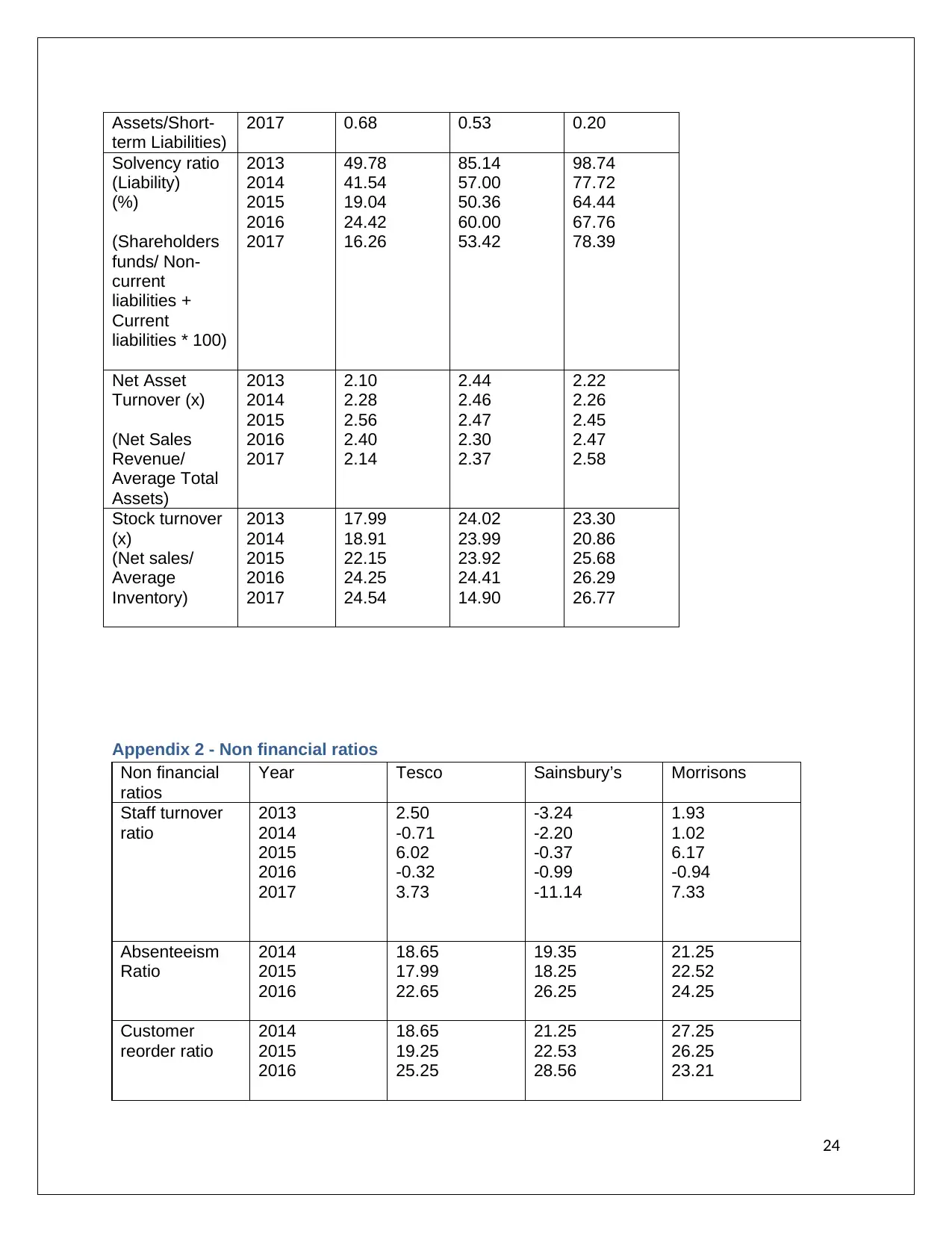
Assets/Short-
term Liabilities)
2017 0.68 0.53 0.20
Solvency ratio
(Liability)
(%)
(Shareholders
funds/ Non-
current
liabilities +
Current
liabilities * 100)
2013
2014
2015
2016
2017
49.78
41.54
19.04
24.42
16.26
85.14
57.00
50.36
60.00
53.42
98.74
77.72
64.44
67.76
78.39
Net Asset
Turnover (x)
(Net Sales
Revenue/
Average Total
Assets)
2013
2014
2015
2016
2017
2.10
2.28
2.56
2.40
2.14
2.44
2.46
2.47
2.30
2.37
2.22
2.26
2.45
2.47
2.58
Stock turnover
(x)
(Net sales/
Average
Inventory)
2013
2014
2015
2016
2017
17.99
18.91
22.15
24.25
24.54
24.02
23.99
23.92
24.41
14.90
23.30
20.86
25.68
26.29
26.77
Appendix 2 - Non financial ratios
Non financial
ratios
Year Tesco Sainsbury’s Morrisons
Staff turnover
ratio
2013
2014
2015
2016
2017
2.50
-0.71
6.02
-0.32
3.73
-3.24
-2.20
-0.37
-0.99
-11.14
1.93
1.02
6.17
-0.94
7.33
Absenteeism
Ratio
2014
2015
2016
18.65
17.99
22.65
19.35
18.25
26.25
21.25
22.52
24.25
Customer
reorder ratio
2014
2015
2016
18.65
19.25
25.25
21.25
22.53
28.56
27.25
26.25
23.21
24
term Liabilities)
2017 0.68 0.53 0.20
Solvency ratio
(Liability)
(%)
(Shareholders
funds/ Non-
current
liabilities +
Current
liabilities * 100)
2013
2014
2015
2016
2017
49.78
41.54
19.04
24.42
16.26
85.14
57.00
50.36
60.00
53.42
98.74
77.72
64.44
67.76
78.39
Net Asset
Turnover (x)
(Net Sales
Revenue/
Average Total
Assets)
2013
2014
2015
2016
2017
2.10
2.28
2.56
2.40
2.14
2.44
2.46
2.47
2.30
2.37
2.22
2.26
2.45
2.47
2.58
Stock turnover
(x)
(Net sales/
Average
Inventory)
2013
2014
2015
2016
2017
17.99
18.91
22.15
24.25
24.54
24.02
23.99
23.92
24.41
14.90
23.30
20.86
25.68
26.29
26.77
Appendix 2 - Non financial ratios
Non financial
ratios
Year Tesco Sainsbury’s Morrisons
Staff turnover
ratio
2013
2014
2015
2016
2017
2.50
-0.71
6.02
-0.32
3.73
-3.24
-2.20
-0.37
-0.99
-11.14
1.93
1.02
6.17
-0.94
7.33
Absenteeism
Ratio
2014
2015
2016
18.65
17.99
22.65
19.35
18.25
26.25
21.25
22.52
24.25
Customer
reorder ratio
2014
2015
2016
18.65
19.25
25.25
21.25
22.53
28.56
27.25
26.25
23.21
24
Secure Best Marks with AI Grader
Need help grading? Try our AI Grader for instant feedback on your assignments.

25
1 out of 26
![[object Object]](/_next/static/media/star-bottom.7253800d.svg)





